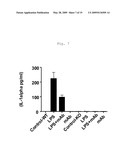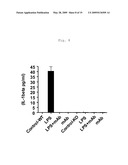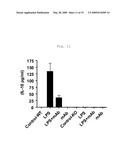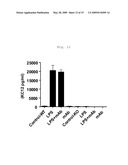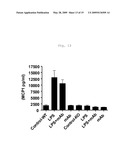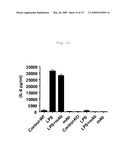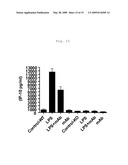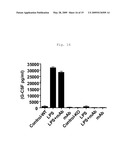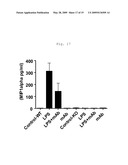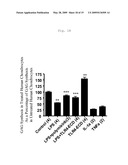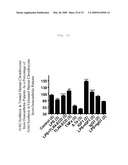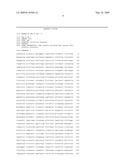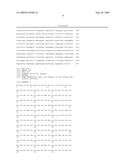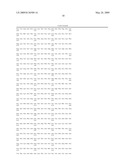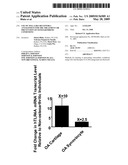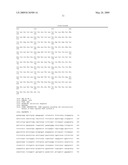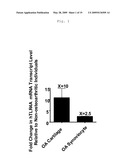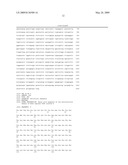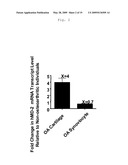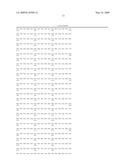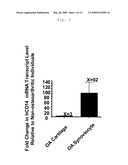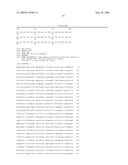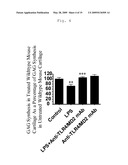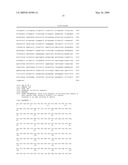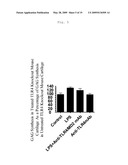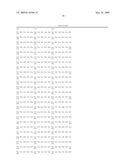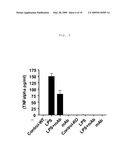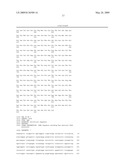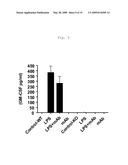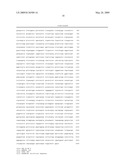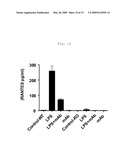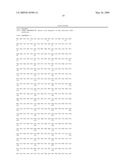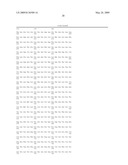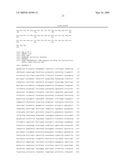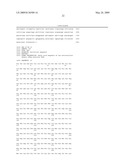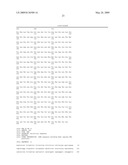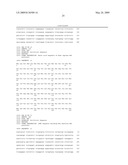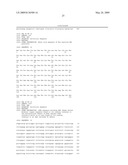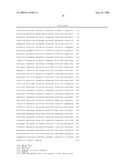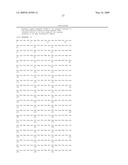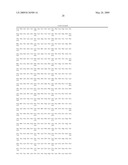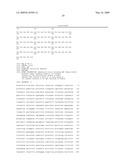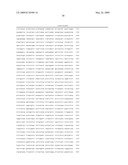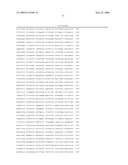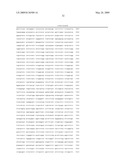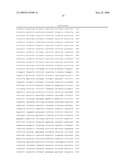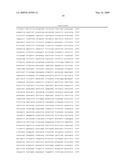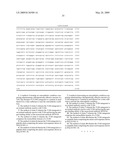Patent application title: Use of Toll-Like Receptor 4 Antagonists for the Treatment or Prevention of Osteoarthritic Conditions
Inventors:
Simon Blake (Radnor, PA, US)
Vedrana Stojanovic-Susulic (Radnor, PA, US)
Mark Ware (San Diego, CA, US)
Linda Wu (Radnor, PA, US)
IPC8 Class: AA61K39395FI
USPC Class:
4241391
Class name: Drug, bio-affecting and body treating compositions immunoglobulin, antiserum, antibody, or antibody fragment, except conjugate or complex of the same with nonimmunoglobulin material binds antigen or epitope whose amino acid sequence is disclosed in whole or in part (e.g., binds specifically-identified amino acid sequence, etc.)
Publication date: 2009-05-28
Patent application number: 20090136509
Claims:
1. A method of treating an osteoarthritic condition comprising
administering a therapeutically effective amount of a Toll Like Receptor
4 (TLR4) antagonist to a patient in need thereof for a time sufficient to
treat the osteoarthritic condition.
2. The method of claim 1 wherein the TLR4 antagonist is an isolated antibody reactive with TLR4.
3. The method of claim 1 wherein the TLR4 antagonist is an isolated antibody reactive with TLR4 and having the antigen binding ability of the monoclonal antibody MTS510.
4. The method of claim 1 wherein the TLR4 antagonist comprises the extracellular domain of a TLR4.
5. The method of claim 4 wherein the TLR4 antagonist is a peptide chain comprising the amino acid sequence shown in SEQ ID NO: 4.
6. The method of claim 4 wherein the TLR4 antagonist is a peptide chain comprising the amino acid sequence shown in SEQ ID NO: 10.
7. A method of preventing an osteoarthritic condition comprising administering a therapeutically effective amount of a TLR4 antagonist to a patient in need thereof for a time sufficient to prevent the osteoarthritic condition.
8. The method of claim 7 wherein the TLR4 antagonist is an isolated antibody reactive with TLR4.
9. The method of claim 7 wherein the TLR4 antagonist is an isolated antibody reactive with TLR4 and having the antigen binding ability of the monoclonal antibody MTS510.
10. The method of claim 7 wherein the TLR4 antagonist comprises the extracellular domain of a TLR4.
11. The method of claim 10 wherein the TLR4 antagonist is a peptide chain comprising the amino acid sequence shown in SEQ ID NO: 4.
12. The method of claim 10 wherein the TLR4 antagonist is a peptide chain comprising the amino acid sequence shown in SEQ ID NO: 10.
Description:
CROSS-REFERENCE TO RELATED APPLICATIONS
[0001]This application claims the benefit of U.S. Provisional Application Ser. No. 60/984,044, filed 31 Oct. 2007, the entire contents of which is incorporated herein by reference.
FIELD OF THE INVENTION
[0002]The present invention relates to therapeutic and prophylactic uses of Toll-Like Receptor 4 (TLR4) antagonists.
BACKGROUND OF THE INVENTION
[0003]Osteoarthritis is a joint disease characterized by degeneration of the articular cartilage, excessive bone growth at the joint margins, and changes in the synovial membranes that produce the lubricating fluids which surround the joints (e.g., knee, hip, elbow).
[0004]Osteoarthritis represents a significant challenge in health care. Osteoarthritis can be painful and debilitating. Advanced osteoarthritis may require surgeries such as joint replacements or other types of medical intervention. In many individuals symptoms of osteoarthritis begin to appear at middle age, but by age 70 the majority of adults of both genders will be diagnosed with osteoarthritis (Beers and Berkow, Eds. The Merck Manual, 17th Edition, Centennial Edition (2003)). In the United States alone more than 20,000,000 people annually are affected by osteoarthritis (Goldring and Goldring, 213 J. Cell Physiol. 626 (2007)).
[0005]In many cases, osteoarthritis is believed to progress, in part, by a mechanism involving cycles of cytokine mediated inflammation, cartilage degradation, and cartilage producing chondrocyte cell death. In other cases, mechanical injury or defects in cartilage production or maintenance can initiate the onset of "osteoarthritis." Chondrocytes are a cell type that produces and maintain cartilage and are believed to be the cell type responsible for the initiation of osteoarthritis.
[0006]Toll Like Receptor 4 (TLR4) forms a receptor complex with the accessory proteins MD2 and CD14 that is activated by exogenous ligands such as lipopolysaccharide (LPS) which binds the MD2 component; TLR4 may also be activated by endogenous ligands (Vistin et al., 175 J. Immunol. 6465 (2005)). Activated TLR4 initiates pro-inflammatory cytokine release and TLR4 activity is believed to play a role in the immune response to infection by gram-negative bacteria which produce LPS (Vistin et al., 175 J. Immunol. 6465 (2005)).
[0007]TLR4s, however, may also have important roles in other biological pathways. For example, TLR4 has been shown to be expressed at elevated levels in osteoarthitic cartilage lesions and LPS activation of TLR4 has been shown to increase production of cartilage degradation products by chondrocytes (Kim et al., 54 Arthritis Rheum. 2152 (2006)). Subsequent work with transgenic mice (Mus musculus) in which the TLR4 gene has been inactivated indicates that this LPS induced cartilage degradation product release is mediated by TLR4 (Bobacz et al., 56 Arthritis Rheum. 1880 (2007)).
[0008]Thus, a need exists to understand the role of TLR4 in osteoarthritis and exploit this role to develop agents, such as antagonists, and therapies that effectively treat or prevent osteoarthritic conditions.
BRIEF DESCRIPTION OF THE DRAWINGS
[0009]FIG. 1 shows hTLR4A transcript levels are increased in articular cartilage and synoviocytes from human osteoarthritis patients relative to articular cartilage and synoviocytes from non-osteoarthritic individuals.
[0010]FIG. 2 shows MD2 transcript levels are increased in articular cartilage but not in synoviocytes from human osteoarthritis patients relative to articular cartilage and synoviocytes from non-osteoarthritic individuals.
[0011]FIG. 3 shows CD14 transcript levels are increased in articular cartilage and synoviocytes from human osteoarthritis patients relative to articular cartilage and synoviocytes from non-osteoarthritic individuals.
[0012]FIG. 4 shows S-GAG synthesis in lipopolysaccahride (LPS), TLR4/MD2 complex binding antagonist mAb (MTS510), or LPS and MTS510 treated articular cartilage from wild-type mice (Mus musculus) as a percentage of GAG synthesis in untreated articular cartilage from wild-type mice.
[0013]FIG. 5 shows S-GAG synthesis in LPS, TLR4/MD2 complex binding antagonist mAb (MTS510), or LPS and MTS510 treated articular cartilage from mTLR4 knockout mice (Mus musculus) as a percentage of GAG synthesis in untreated articular cartilage from mTLR4 knockout mice.
[0014]FIG. 6 shows TNF-alpha secretion in LPS, TLR4/MD2 complex binding antagonist mAb (MTS510), or LPS and MTS510 treated articular cartilage from wild-type and mTLR4 knockout mice (Mus musculus).
[0015]FIG. 7 shows IL-1alpha secretion in LPS, TLR4/MD2 complex binding antagonist mAb (MTS510), or LPS and MTS510 treated articular cartilage from wild-type and mTLR4 knockout mice (Mus musculus).
[0016]FIG. 8 shows IL-1beta secretion in LPS, TLR4/MD2 complex binding antagonist mAb (MTS510), or LPS and MTS510 treated articular cartilage from wild-type and mTLR4 knockout mice (Mus musculus).
[0017]FIG. 9 shows GM-CSF secretion in LPS, TLR4/MD2 complex binding antagonist mAb (MTS510), or LPS and MTS510 treated articular cartilage from wild-type and mTLR4 knockout mice (Mus musculus).
[0018]FIG. 10 shows RANTES secretion in LPS, TLR4/MD2 complex binding antagonist mAb (MTS510), or LPS and MTS510 treated articular cartilage from wild-type and mTLR4 knockout mice (Mus musculus).
[0019]FIG. 11 shows IL-10 secretion in LPS, TLR4/MD2 complex binding antagonist mAb (MTS510), or LPS and MTS510 treated articular cartilage from wild-type and mTLR4 knockout mice (Mus musculus).
[0020]FIG. 12 shows KC12 secretion in LPS, TLR4/MD2 complex binding antagonist mAb (MTS510), or LPS and MTS510 treated articular cartilage from wild-type and mTLR4 knockout mice (Mus musculus).
[0021]FIG. 13 shows MCP1 secretion in LPS, TLR4/MD2 complex binding antagonist mAb (MTS510), or LPS and MTS510 treated articular cartilage from wild-type and mTLR4 knockout mice (Mus musculus).
[0022]FIG. 14 shows IL-6 secretion in LPS, TLR4/MD2 complex binding antagonist mAb (MTS510), or LPS and MTS510 treated articular cartilage from wild-type and mTLR4 knockout mice (Mus musculus).
[0023]FIG. 15 shows IP-10 secretion in LPS, TLR4/MD2 complex binding antagonist mAb (MTS510), or LPS and MTS510 treated articular cartilage from wild-type and mTLR4 knockout mice (Mus musculus).
[0024]FIG. 16 shows G-CSF secretion in LPS, TLR4/MD2 complex binding antagonist mAb (MTS510), or LPS and MTS510 treated articular cartilage from wild-type and mTLR4 knockout mice (Mus musculus).
[0025]FIG. 17 shows MIP-1alpha secretion in LPS, TLR4/MD2 complex binding antagonist mAb (MTS510), or LPS and MTS510 treated articular cartilage from wild-type and mTLR4 knockout mice (Mus musculus).
[0026]FIG. 18 shows S-GAG synthesis in LPS, LPS and polymixin B, LPS and the TLR4 antagonist TLR4-ECD, TLR4-ECD alone, IL-1alpha (IL-1a), or TNFalpha (TNFa) treated human chondrocytes as a percentage of GAG synthesis in untreated human chondrocytes.
[0027]FIG. 19 shows S-GAG synthesis in LPS, LPS and the TLR4 antagonist TLR4-ECD, TLR4-ECD alone, TNFalpha (TNFa), IL-1alpha (IL1a), IGF1 (Insulin-like Growth Factor 1), LPS and IGF1, IgG1, or LPS and IgG1 treated human chondrocytes from osteoarthritic patients as a percentage of GAG synthesis in untreated human chondrocytes from osteoarthritic patients.
SUMMARY OF THE INVENTION
[0028]One aspect of the invention is a method of treating an osteoarthritic condition comprising administering a therapeutically effective amount of a Toll Like Receptor 4 (TLR4) antagonist to a patient in need thereof for a time sufficient to treat the osteoarthritic condition.
[0029]Another aspect of the invention is a method of preventing an osteoarthritic condition comprising administering a therapeutically effective amount of a TLR4 antagonist to a patient in need thereof for a time sufficient to prevent the osteoarthritic condition.
DETAILED DESCRIPTION OF THE INVENTION
[0030]All publications, including but not limited to patents and patent applications, cited in this specification are herein incorporated by reference as though fully set forth.
[0031]The term "antagonist" as used herein means a molecule that partially or completely inhibits, by any mechanism, an effect of another molecule such as a receptor. As used herein, a "TLR4 antagonist" or a compound "reactive with TLR4" describes a molecule that is capable of, directly or indirectly, substantially counteracting, reducing or inhibiting TLR4 biological activity or TLR4 receptor activation. Such antagonists may be, for example, small organic molecules, peptide chains, antibodies, antibody fragments, MIMETIBODY® peptide chains or polynucleotides. Such antagonists may, for example, disrupt the activity of TLR4 by preventing activation or formation of functional complexes comprising TLR4 (e.g. by disrupting MD2 homolog or CD14 homolog activity). The amino acid sequences shown in SEQ ID NO: 12 and SEQ ID NO: 14 are repectively those of Homo sapiens (human) MD2 and Mus musculus (mouse) MD2.
[0032]Examples of specific TLR4 antagonists include mAb MTS510, antagonists such as TLR4-ECD which comprises the extracellular domain of a hTLR4A fused to an Fc domain (SEQ ID NO: 2) and others. mAb MTS510 is a monoclonal rat antibody of the IgG2a isotype which binds Mus musculus (mouse) TLR4 and is capable of binding mTLR4 complexed with MD2 as well as inhibiting TLR4 activity. mAb MTS510 is produced by a clone designated MTS510 and is suitable for lyophylization. mAb MTS510 can be obtained from Invivo Gen (San Diego, Calif.) or eBioscience, Inc. (San Diego, Calif.). TLR4-ECD type constructs such as those comprising the amino acid sequence shown in SEQ ID NO: 4 and SEQ ID NO: 10 can also inhibit TLR4 activity and are believed to antagonize TLR4 by inhibiting the interaction of MD2 with TLR4 thus preventing the LPS binding MD2 peptide chain from activating TLR4. The amino acid sequences shown in SEQ ID NO: 6 and SEQ ID NO: 16 are specific examples of such TLR4-ECD construct.
[0033]TLR4 antagonists useful in the methods of the invention may also be nucleic acid molecules. Such nucleic acid molecules may be interfering nucleic acid molecules such as short interfering RNAs or antisense molecules that are TLR4 antagonists. Alternatively, polynucleotide molecules such as double and single stranded plasmid DNA vectors, artificial chromosomes, or linear nucleic acids or other vectors that encode a TLR4 antagonist (e.g. peptide chain or RNA), or function as a TLR4 antagonist, may be used in the methods of the invention to administer a TLR4 antagonist to a patient.
[0034]The term "antibodies" as used herein is meant in a broad sense and includes immunoglobulin or antibody molecules including polyclonal antibodies, monoclonal antibodies including murine, human, humanized and chimeric monoclonal antibodies and antibody fragments.
[0035]In general, antibodies are proteins or polypeptides that exhibit binding specificity to a specific antigen. Intact antibodies are heterotetrameric glycoproteins, composed of two identical light chains and two identical heavy chains. Typically, each light chain is linked to a heavy chain by one covalent disulfide bond, while the number of disulfide linkages varies between the heavy chains of different immunoglobulin isotypes. Each heavy and light chain also has regularly spaced intrachain disulfide bridges. Each heavy chain has at one end a variable domain (VH) followed by a number of constant domains. Each light chain has a variable domain at one end (VL) and a constant domain at its other end; the constant domain of the light chain is aligned with the first constant domain of the heavy chain and the light chain variable domain is aligned with the variable domain of the heavy chain. Antibody light chains of any vertebrate species can be assigned to one of two clearly distinct types, namely kappa (κ) and lambda (λ), based on the amino acid sequences of their constant domains. Immunoglobulins can be assigned to five major classes, namely IgA, IgD, IgE, IgG and IgM, depending on the heavy chain constant domain amino acid sequence. IgA and IgG are further sub-classified as the isotypes IgA1, IgA2, IgG1, IgG2, IgG3 and IgG4.
[0036]The term "antibody fragments" means a portion of an intact antibody, generally the antigen binding or variable region of the intact antibody. Examples of antibody fragments include Fab, Fab', F(ab')2 and Fv fragments, diabodies, single chain antibody molecules and multispecific antibodies formed from at least two intact antibodies.
[0037]The term "antigen" as used herein means any molecule that has the ability to generate antibodies either directly or indirectly. Included within the definition of "antigen" is a protein-encoding nucleic acid.
[0038]"CDRs" are defined as the complementarity determining region amino acid sequences of an antibody which are the hypervariable regions of immunoglobulin heavy and light chains. See, e.g., Kabat et al., Sequences of Proteins of Immunological Interest, 4th ed., U.S. Department of Health and Human Services, National Institutes of Health (1987). There are three heavy chain and three light chain CDRs or CDR regions in the variable portion of an immunoglobulin. Thus, "CDRs" as used herein refers to all three heavy chain CDRs, or all three light chain CDRs or both all heavy and all light chain CDRs, if appropriate.
[0039]CDRs provide the majority of contact residues for the binding of the antibody to the antigen or epitope. CDRs of interest useful in this invention are derived from donor antibody variable heavy and light chain sequences, and include analogs of the naturally occurring CDRs, which analogs also share or retain the same antigen binding specificity and/or neutralizing ability as the donor antibody from which they were derived.
[0040]The term "homolog" as used herein means protein sequences having between 75% and 100% sequence identity to a reference sequence. For example, homologs of the mature form of the Homo sapiens MD-2 protein would include those peptide chains that have between 75% and 100% sequence identity to amino acid residues 17 to 160 of SEQ ID NO: 12. Percent identity between two peptide chains can be determined by pair wise alignment using the default settings of the AlignX module of Vector NTI v.9.0.0 (Invitrogen Corp., Carslbad, Calif.).
[0041]The term "in combination with" as used herein means that the described agents can be administered to an animal together in a mixture, concurrently as single agents or sequentially as single agents in any order.
[0042]The term "inflammatory condition" as used herein means a localized response to cellular injury that is mediated in part by the activity of cytokines, chemokines, or inflammatory cells (e.g., neutrophils, monocytes and lymphocytes) which is characterized in most instances by pain, redness, swelling and loss of tissue function.
[0043]The term "MIMETIBODY® peptide chain" as used herein means a protein having the generic formula (I):
(V1-Pep-Lk-V2-Hg-CH2-CH3)(t) (I)
where V1 is a portion of an N-terminus of an immunoglobulin variable region, Pep is a polypeptide that binds to cell surface TLR4, Lk is a polypeptide or chemical linkage, V2 is a portion of a C-terminus of an immunoglobulin variable region, Hg is a portion of an immunoglobulin hinge region, CH2 is an immunoglobulin heavy chain CH2 constant region and CH3 is an immunoglobulin heavy chain CH3 constant region and t is independently an integer of 1 to 10. A MIMETIBODY® peptide chain can mimic properties and functions of different types of immunoglobulin molecules such as IgG1, IgG2, IgG3, IgG4, IgA, IgM, IgD and IgE dependent on the heavy chain constant domain amino acid sequence present in the construct. In some MIMETIBODY® peptide chain embodiments, V1 may be absent. A MIMETIBODY® peptide chain antagonist useful in the present invention affects TLR4 biological activity through binding to cell surface TLR4.
[0044]The term "monoclonal antibody" (mAb) as used herein means an antibody (or antibody fragment) obtained from a population of substantially homogeneous antibodies. Monoclonal antibodies are highly specific, typically being directed against a single antigenic determinant. The modifier "monoclonal" indicates the substantially homogeneous character of the antibody and does not require production of the antibody by any particular method. For example, murine mAbs can be made by the hybridoma method of Kohler et al., Nature 256:495-497 (1975). Chimeric mAbs containing a light chain and heavy chain variable region derived from a donor antibody (typically murine) in association with light and heavy chain constant regions derived from an acceptor antibody (typically another mammalian species such as human) can be prepared by the method disclosed in U.S. Pat. No. 4,816,567. Humanized mAbs having CDRs derived from a non-human donor immunoglobulin (typically murine) and the remaining immunoglobulin-derived parts of the molecule being derived from one or more human immunoglobulins, optionally having altered framework support residues to preserve binding affinity, can be obtained by the techniques disclosed in Queen et al., Proc. Natl. Acad. Sci. (USA), 86:10029-10032 (1989) and Hodgson et al., Bio/Technology, 9:421 (1991).
[0045]Exemplary human framework sequences useful for humanization are disclosed at, e.g., www.ncbi.nlm.nih.gov/entrez/query.fcgi; www.ncbi.nih.gov/igblast; www.atcc.org/phage/hdb.html; www.mrc-cpe.cam.ac.uk/ALIGNMENTS.php; www.kabatdatabase.com/top.html; ftp.ncbi.nih.gov/repository/kabat; www.sciquest.com; www.abcam.com; www.antibodyresource.com/onlinecomp.html; www.public.iastate.edu/˜pedro/research_tools.html; www.whfreeman.com/immunology/CH05/kuby05.htm; www.hhmi.org/grants/lectures/1996/vlab; www.path.cam.ac.uk/˜mrc7/mikeimages.html; mcb.harvard.edu/BioLinks/Immunology.html; www.immunologylink.com; pathbox.wust1.edu/˜hcenter/index.html; www.appliedbiosystems.com; www.nal.usda.gov/awic/pubs/antibody; www.m.ehime-u.ac.jp/˜yasuhito/Elisa.html; www.biodesign.com; www.cancerresearchuk.org; www.biotech.ufl.edu; www.isac-net.org; baserv.uci.kun.n1/˜jraats/links1.html; www.recab.uni-hd.de/immuno.bme.nwu.edu; www.mrc-cpe.cam.ac.uk; www.ibt.unam.mx/vir/V_mice.html; http://www.bioinf.org.uk/abs; antibody.bath.ac.uk; www.unizh.ch; www.cryst.bbk.ac.uk/˜ubcg07s; www.nimr.mrc.ac.uk/CC/ccaewg/ccaewg.html; www.path.cam.ac.uk/˜mrc7/humanisation/TAHHP.html; www.ibt.unam.mx/vir/structure/stat_aim.html; www.biosci.missouri.edu/smithgp/index.html; www.jerini.de; and Kabat et al., Sequences of Proteins of Immunological Interest, U.S. Dept. Health (1987), each entirely incorporated herein by reference.
[0046]Fully human mAbs lacking any non-human sequences can be prepared from human immunoglobulin transgenic mice by techniques referenced in, e.g., Lonberg et al., Nature 368:856-859 (1994); Fishwild et al., Nature Biotechnology 14:845-851 (1996) and Mendez et al., Nature Genetics 15:146-156 (1997). Human mAbs can also be prepared and optimized from phage display libraries by techniques referenced in, e.g., Knappik et al., J. Mol. Biol. 296:57-86 (2000) and Krebs et al., J. Immunol. Meth. 254:67-84 (2001).
[0047]The terms "osteoarthritic condition" or "osteoarthritis" as used herein means a joint disease characterized by degeneration of the articular cartilage, hypertrophy of bone at the joint margins, and changes in the synovial membrane. In many cases "osteoarthritis" is believed to progress, in part, by a mechanism involving cycles of cytokine mediated inflammation, cartilage degradation, and cartilage producing chondrocyte cell death. In other cases, mechanical injury or defects in cartilage production or maintenance can initiate the onset of "osteoarthritis."
[0048]The term "patient" means an animal belonging to any genus for which treatment of an osteoarthritic condition or prevention of an osteoarthritic condition is indicated.
[0049]The term "peptide chain" means a molecule that comprises at least two amino acid residues linked by a peptide bond to form a chain. Large peptide chains of more than 50 amino acids may be referred to as "polypeptides" or "proteins." Small peptide chains of less than 50 amino acids may be referred to as "peptides."
[0050]In the methods of the invention a "therapeutically effective amount" of a TLR4 antagonist means those doses that, in a given individual patient, produce a response that results in improvement and treatment of one or more symptoms of an ostearthritic condition (e.g. inflammatory cytokine levels). Alternatively, in the methods of the invention a "therapeutically effective amount" of a TLR4 antagonist means those doses that, in a particular individual patient, prevent one or more symptoms of an osteoarthritic condition in an individual such as, for example, an individual pre-disposed to osteoarthritis (e.g. due to mechanical injury to a joint and cartilage or due to defects in cartilage production and maintenance). Therapeutically effective amounts, or doses, appropriate for an individual patient can be readily determined using routine clinical techniques well known by those of skill in the art (e.g. dose response plots).
[0051]The term "TLR4" means a peptide chain comprising an amino acid sequence with at least 60% identity to residues 24 to 631 of the amino acid sequence shown in SEQ ID NO: 2 or a complex of peptide chains (e.g. MD2 and CD14) comprising such a peptide chain. SEQ ID NO: 2 shows the amino acid sequence of the Homo sapiens (human) TLR4 isoform A precursor (hTLR4A). Percent identity between two peptide chains can be determined by pair wise alignment using the default settings of the AlignX module of Vector NTI v.9.0.0 (Invitrogen Corp., Carslbad, Calif.).
[0052]The term "TLR4 biological activity" or "TLR4 receptor activation" as used herein refers to any activities occurring as a result of ligand binding to TLR4 or complexes comprising a TLR4.
[0053]The term "extracellular domain of a TLR4" means a peptide chain comprising an amino acid sequence with at least 60% identity to residues 24 to 631 of the amino acid sequence shown in SEQ ID NO: 2.
[0054]Several other sequences relevant to different aspects of the invention are disclosed. These are the sequences shown in SEQ ID NOs 1, 5, 7, 8, 9, 11, 13, 15, and 17. SEQ ID NO: 1 shows a cDNA sequence encoding Homo sapiens TLR4 isoform A precursor. SEQ ID NO: 5 shows a cDNA sequence encoding the extracellular domain of Homo sapiens TLR4 isoform A fused at its carboxy terminus to an IgG1 antibody Fc domain. SEQ ID NO: 7 shows a cDNA sequence encoding Mus musculus TLR4 precursor. SEQ ID NO: 8 shows the amino acid sequence of a Mus musculus TLR4 precursor. SEQ ID NO: 9 shows a cDNA sequence encoding the extracellular domain of Mus musculus TLR4. SEQ ID NO: 11 shows a cDNA sequence encoding Homo sapiens MD2 precursor. SEQ ID NO: 13 shows a cDNA sequence encoding Mus musculus MD2 precursor. SEQ ID NO: 15 shows a cDNA sequence encoding an HGH (Human Growth Hormone) signal sequence fused at its carboxy terminus to the extracellular domain of Homo sapiens TLR4 isoform A which is in turn fused at its carboxy terminus to an IgG1 antibody Fc domain. SEQ ID NO: 17 shows the nucleic acid sequence of an expression vector encoding an HGH (Human Growth Hormone) signal sequence fused at its carboxy terminus to the extracellular domain of Homo sapiens TLR4 isoform A which is in turn fused at its carboxy terminus to an IgG1 antibody Fc domain.
[0055]One aspect of the invention is a method of treating an osteoarthritic condition comprising administering a therapeutically effective amount of a Toll Like Receptor 4 (TLR4) antagonist to a patient in need thereof for a time sufficient to treat the osteoarthritic condition.
[0056]Another aspect of the invention is a method of preventing an osteoarthritic condition comprising administering a therapeutically effective amount of a TLR4 antagonist to a patient in need thereof for a time sufficient to prevent the osteoarthritic condition.
[0057]The TLR4 antagonists useful in the methods of the invention may have the properties of binding a TLR4 receptor and inhibiting TLR4 receptor-mediated signaling. Exemplary mechanisms by which TLR4 signaling may be inhibited by such antagonists include inhibition of kinase activity, transcript reduction or receptor antagonism. Use of other antagonists capable of inhibiting TLR4 receptor-mediated signaling by other mechanisms are also useful in the methods of the invention.
[0058]The methods of the invention may be used to treat an animal patient belonging to any genus. Examples of such animals include humans, mice, birds, reptiles, and fish. Without wishing to be bound by any particular theory, it is believed that the therapeutic benefit of TLR4 antagonists will be due to the ability of such antagonists to inhibit the secretion of pro-inflammatory chemokines and cytokines involved in inflammatory conditions.
[0059]Amounts of a given TLR4 antagonist sufficient to treat a given inflammatory condition can be readily determined. In the method of the invention the TLR4 antagonist may be administered singly or in combination with at least one other molecule. Such additional molecules may be other TLR4 antagonist molecules or molecules with a therapeutic benefit not mediated by TLR4 receptor signaling. Antibiotics, antivirals, other immunomodulators, other anti-inflammatory agents, leukotriene antagonists, β2 agonists and muscarinic receptor antagonists are examples of such additional molecules.
[0060]The mode of administration for therapeutic use of the antagonists of the invention may be any suitable route that delivers the agent to the host. The proteins, antibodies, antibody fragments and MIMETIBODY® peptide chains and pharmaceutical compositions of these agents are particularly useful for parenteral administration, i.e., intrarticularly, subcutaneously, intramuscularly, intradermally, intravenously or intranasally.
[0061]Antagonists useful in the methods of the invention may be prepared as pharmaceutical compositions containing an effective amount of the antagonist as an active ingredient in a pharmaceutically acceptable carrier. An aqueous suspension or solution containing the antagonist, preferably buffered at physiological pH, in a form ready for injection is preferred. The compositions for parenteral administration will commonly comprise a solution of the antagonist of the invention or a cocktail thereof dissolved in an pharmaceutically acceptable carrier, preferably an aqueous carrier. A variety of aqueous carriers may be employed, e.g., 0.4% saline, 0.3% glycine and the like. These solutions are sterile and generally free of particulate matter. These solutions may be sterilized by conventional, well-known sterilization techniques (e.g., filtration). The compositions may contain pharmaceutically acceptable auxiliary substances as required to approximate physiological conditions such as pH adjusting and buffering agents, etc. The concentration of the antagonist of the invention in such pharmaceutical formulation can vary widely, i.e., from less than about 0.5%, usually at or at least about 1% to as much as 15 or 20% by weight and will be selected primarily based on fluid volumes, viscosities, etc., according to the particular mode of administration selected.
[0062]Thus, a pharmaceutical composition useful in the methods of the invention for intramuscular injection could be prepared to contain 1 mL sterile buffered water, and between about 1 ng to about 100 mg, e.g. about 50 ng to about 30 mg or more preferably, about 5 mg to about 25 mg, of an TLR4 antagonist. Similarly, a pharmaceutical composition of the invention for intravenous infusion could be made up to contain about 250 ml of sterile Ringer's solution, and about 1 mg to about 30 mg and preferably 5 mg to about 25 mg of an TLR4 antagonist of the invention. Actual methods for preparing parenterally administrable compositions are well known and are described in more detail in, for example, "Remington's Pharmaceutical Science", 15th ed., Mack Publishing Company, Easton, Pa. Doses of TLR4 antagonists such as mAbs (e.g. MTS510) or TLR4-ECD may be between about 0.01 mg per kg of animal body weight or 5 mg per kg of animal body weight.
[0063]The TLR4 antagonists useful in the methods of the invention, when in a pharmaceutical preparation, can be present in unit dose forms. The appropriate therapeutically effective amount, or dose, can be determined readily by those of skill in the art. A determined dose may, if necessary, be repeated at appropriate time intervals selected as appropriate by a physician during the treatment period.
[0064]The peptide chain TLR4 antagonists useful in the methods of the invention can be lyophilized for storage and reconstituted in a suitable carrier prior to use. This technique has been shown to be effective with conventional immunoglobulins and protein preparations and art-known lyophilization and reconstitution techniques can be employed.
[0065]In some embodiments of the methods of the invention the TLR4 antagonist is an isolated antibody reactive with TLR4. An antibody is reactive with a TLR4 when, for example, it specifically binds a given TLR4 peptide chain (e.g. Homo sapiens TLR4 isoform A) or a complex comprising a TLR4. The binding of an antagonist, such as a antibody reactive with TLR4, is specific for a given peptide chain when such binding can be used to detect the presence of a first peptide chain (e.g. Homo sapiens TLR4 isoform A), but not a second non-homologous peptide chain (e.g. albumin). This specific binding can be used to distinguish the two peptide chains from each other. Specific binding can be assayed using conventional techniques such as ELISAs and Western blots as well as other techniques well known in the art.
[0066]Exemplary antibody antagonists may be antibodies of the IgG, IgD, IgGa or IgM isotypes. Additionally, such antagonist antibodies can be post-translationally modified by processes such as glycosylation, isomerization, aglycosylation or non-naturally occurring covalent modification such as the addition of polyethylene glycol moieties (pegylation) and lipidation. Such modifications may occur in vivo or in vitro. Fully human, humanized and affinity-matured antibody molecules or antibody fragments are useful in the methods of the invention as are MIMETIBODY® peptide chains, fusion proteins and chimeric proteins.
[0067]The antibody antagonists useful in the methods of the invention may specifically bind a TLR4 or complexes comprising a TLR4 with a Kd less than or equal to about 10-7, 10-8, 10-9, 10-10, 10-11 or 10-12 M. The affinity of a given molecule for a TLR4 receptor or complex comprising a TLR4 can be determined experimentally using any suitable method. Such methods may utilize Biacore or KinExA instrumentation, ELISA or competitive binding assays known to those skilled in the art.
[0068]Antibody antagonist molecules binding a given TLR4 homolog with a desired affinity can be selected from libraries of protein variants or fragments by techniques including antibody affinity maturation and other art-recognized techniques suitable for non-antibody molecules.
[0069]In some embodiments of the methods of the invention the TLR4 antagonist is an isolated antibody reactive with TLR4 and having the antigen binding ability of the monoclonal antibody MTS510. A isolated antibody reactive with TLR4 has the antigen binding ability of mAb MTS510 when such an isolated antibody competes with mAb MTS510 for binding of a given TLR4 molecule in standard competitive binding assays. Such assays include competitive binding ELISA assays, for example. Those skilled in the art will also recognize other methods appropriate for detecting competition for antigen binding between two antibodies.
[0070]TLR4 antagonist antibodies useful in the methods of the invention can further comprise human framework regions selected for their homology to the rat heavy chain amino acid sequence and to the rat light chain amino acid sequence of mAb MTS510.
[0071]In some embodiments of the methods of the invention the TLR4 antagonist comprises the extracellular domain of a TLR4.
[0072]In some embodiments of the methods of the invention the TLR4 antagonist is a peptide chain comprising the human TLR4 isoform A extracellular domain amino acid sequence shown in SEQ ID NO: 4.
[0073]In some embodiments of the methods of the invention the TLR4 antagonist is a peptide chain comprising the mouse TLR4 isoform A extracellular domain amino acid sequence shown in SEQ ID NO: 10.
[0074]The present invention will now be described with reference to the following specific, non-limiting examples.
EXAMPLE 1
TLR4, MD2, and CD14 Transcript Levels are Increased in Articular Cartilage and Synoviocytes from Human Osteoarthritis Patients
[0075]Homo Sapiens TLR4 Isoform A (hTLR4A) and CD14 transcript levels are increased in articular cartilage and synoviocytes from human osteoarthritis patients relative to articular cartilage and synoviocytes from non-osteoarthritic individuals (FIG. 1 and FIG. 3).
[0076]hTLR4A, MD2, and CD14 transcript levels in total RNA extracted from the articular cartilage and synoviocytes of human osteoarthritis patients and non-osteoarthritic individuals was measured by real time-PCR (RT-PCR). Total RNA was extracted from samples using TriZOl® (Invitrogen Corp., Carlsbad, Calif.) and isolated using the RNEasy Mini Kit (Qiagen Inc., Valencia, Calif.). Isolated RNA was then pooled as necessary.
[0077]cDNAs were prepared from each RNA pool using the Omniscript® kit (Qiagen Inc., Valencia, Calif.) according to the manufacturer's instructions. 100 ng of cDNA was amplified using TaqMan® custom Low Density Array (LDA) Cards (Applied Biosystems, Foster City, Calif.) as directed by the manufacturer. Primer Express® software (Applied Biosystems) was used to design the probe and primer combinations. TaqMan® RT-PCR (Applied Biosystems) was then performed in a 384 well format using ABI PRISM® 7000HT instrumentation (Applied Biosystems) as directed by the manufacturer.
[0078]Data collection and transcript quantization in the early exponential phase of PCR was performed with the ABI PRISM® 7000HT instrumentation and associated software. Individual transcript levels were normalized against transcript levels for 18S ribosomal RNA. Data are expressed as mean fold change in mRNA transcript levels in articular cartilage and synoviocytes from human osteoarthritis patients relative to non-osteoarthritic individuals. Data represents RNA samples from four donors (N=4).
[0079]The data indicate that hTLR4A and CD14 transcript levels are increased in cartilage and synoviocytes from human osteoarthritis patients relative to non-osteoarthritic individuals (FIG. 1 and FIG. 3). MD2 transcript levels are increased in cartilage as shown in FIG. 2. hTLR4A, MD2, and CD14 form a complex which mediates TLR4 signaling in response to activation by ligands such as LPS and other signals. Furthermore, TLR4 activation can increase pro-inflammatory cytokine release (see Example 3 below). Consequently, the results here indicate that TLR4 activation and associated inflammatory responses may play an important role in the occurrence of osteoarthritic conditions.
EXAMPLE 2
Lipopolysaccahride (LPS) Mediated Decreases in the Synthesis of the Articular Cartilage Component Sulfated Glycosaminoglycan (S-GAG) is TLR4 Dependent and Can Be Reversed by a TLR4 Antagonist mAb
[0080]Lipopolysaccahride (LPS) mediated decreases in the synthesis of the articular cartilage component S-GAG is TLR4 dependent and occurs in wild-type mice, but not TLR4 knock-out mice. LPS is an agonist ligand for TLR4 receptors and activates TLR4 mediated signaling. As seen in FIG. 4 and FIG. 5, the synthesis of S-GAG in wild-type mouse articular cartilage explants is decreased by LPS treatment, while LPS treatment of articular cartilage explants from TLR4 knock-out mice does not decrease S-GAG synthesis relative to controls. Importantly, treatment of wild-type mouse articular cartilage explants with LPS and the TLR4/MD2 complex binding antagonist mAb (MTS510) resulted in increased S-GAG synthesis relative to explants treated with LPS alone (FIG. 4).
[0081]For these experiments, articular cartilage explants from the femoral heads of 5 week old wild-type mice (Mus musculus) or TLR4 knock-out mice were removed. TLR4 knock-out mice are mice in which the gene encoding mTLR4 has been inactivated. Cartilage explants were prepared and maintained using standard methods. Cartilage explants were incubated in 200 μL of explant culture medium for 3 to 5 days at which time spent media was removed and replaced with fresh media at experiment Day 0. "Control" explants were untreated explants from wild-type (FIG. 4) or TLR4 knock-out mice (FIG. 5). "LPS" treated explants from wild-type (FIG. 4) or TLR4 knock-out mice (FIG. 5) were treated with LPS at a concentration of 10 ng/ml in the media for three days starting at Day 2. "Anti-TLR4/MD2 mAb" treated explants from wild-type (FIG. 4) or TLR4 knock-out mice (FIG. 5) were treated starting at Day 0 with the TLR4/MD2 complex binding antagonist mAb MTS510 (Invivo Gen or eBioscience, Inc., San Diego, Calif.) at a concentration in the media of 20 μg/ml. "LPS+Anti-TLR4/MD2 mAb" treated explants from wild-type (FIG. 4) or TLR4 knock-out mice (FIG. 5) were treated starting at Day 0 with the TLR4/MD2 complex binding antagonist mAb MTS510 at a concentration in the media of 20 μg/ml, followed by treatment on Day 2 with LPS at a concentration of 10 ng/ml in the media for three days. On Day 5 explants were 35S labeled overnight and 35S incorporation into S-GAG (sulfated glycosaminoglycan) was then determined as described by Bobacz et al. 56 Arthritis. Rheum. 1880 (2007).
[0082]The results here (FIG. 4 and FIG. 5) indicate that antagonists of the activity of TLR4 receptor complexes, such as mab MTS510, can treat and prevent cartilage degradation in conditions such as osteoarthritis. Data in FIG. 4 and FIG. 5 are presented as mean -/+standard deviation with N=4. In FIG. 3 "**"=P<0.05 versus "Control" and "****"=P<0.001 versus "LPS."
EXAMPLE 3
LPS Induced Pro-Inflammatory Cytokine Release from Articular Cartilage Is Dependent on TLR4 Activity
[0083]LPS induced release of the pro-inflammatory cytokines TNF-alpha, IL-1alpha, IL-1beta, GM-CSF, RANTES, IL-10, KC12, MCP1, IL-6, IP-10, G-CSF, and MIP-1alpha from articular cartilage is dependent on TLR4 activity (see FIG. 6, FIG. 7, FIG. 8, FIG. 9, FIG. 10, FIG. 11, FIG. 12, FIG. 13, FIG. 14, FIG. 15, FIG. 16, and FIG. 17). Blocking TLR4 activity with the TLR4 antagonist mAb MTS510, or by knocking out the TLR4 gene in mice, prevented or decreased the release of these pro-inflammatory cytokines (see FIG. 6, FIG. 7, FIG. 8, FIG. 9, FIG. 10, FIG. 11, FIG. 12, FIG. 13, FIG. 14, FIG. 15, FIG. 16, and FIG. 17).
[0084]For these experiments articular cartilage explants from wild-type ("WT") and TLR4 knock-out ("KO") mice were prepared and treated with LPS, as described in Example 2 above. "Control" explants were untreated explants from wild-type or TLR4 knock-out mice. "LPS" treated explants from wild-type or TLR4 knock-out mice were treated with LPS at a concentration of 10 ng/ml in the media for three days starting at Day 2. "mAb" treated explants from wild-type or TLR4 knock-out mice were treated starting at Day 0 with the TLR4/MD2 complex binding antagonist mAb MTS510 at a concentration in the media of 20 μg/ml. "LPS+mAb" treated explants from wild-type or TLR4 knock-out mice were treated starting at Day 0 with the TLR4/MD2 complex binding antagonist mAb MTS510 at a concentration in the media of 20 μg/ml, followed by treatment on Day 2 with LPS at a concentration of 10 ng/ml in the media for three days. Cytokine levels in articular cartilage explant cell culture supernatant media were then measured using LUMINEX® instrumentation (LUMINEX® Corp., Austin, Tex.) TNF-alpha, IL-1alpha, IL-1beta, GM-CSF, RANTES, IL-10, KC12, MCP1, IL-6, IP-10, G-CSF, and MIP-1alpha specific mAb conjugated beads as appropriate. LUMINEX® assays for each cytokine were performed as directed by the manufacturer.
[0085]The results here (see FIG. 6, FIG. 7, FIG. 8, FIG. 9, FIG. 10, FIG. 11, FIG. 12, FIG. 13, FIG. 14, FIG. 15, FIG. 16, and FIG. 17) indicate that antagonism of the activity of TLR4 receptor complexes, such as by mab MTS510 treatment or decreasing TLR4 gene expression, can treat and prevent cartilage degradation in conditions such as osteoarthritis by preventing or decreasing the release of pro-inflammatory cytokines. In FIG. 6, FIG. 7, FIG. 8, FIG. 9, FIG. 10, FIG. 11, FIG. 12, FIG. 13, FIG. 14, FIG. 15, FIG. 16, and FIG. 17 the first four bars represent data from wild-type mouse articular cartilage explants; the remaining four bars represent data from TLR4 knock-out mouse articular cartilage explants. Data in FIG. 6, FIG. 7, FIG. 8, FIG. 9, FIG. 10, FIG. 11, FIG. 12, FIG. 13, FIG. 14, FIG. 15, FIG. 16, and FIG. 17 are presented as mean -/+standard deviation with N=4.
EXAMPLE 4
LPS Mediated Decreases in the Synthesis of the Articular Cartilage Component S-GAG by Human Chondrocytes Can Be Reversed By TLR4 Antagonist hTLR4-ECD Treatment
[0086]Lipopolysaccahride (LPS) mediated decreases in the synthesis of the articular cartilage component S-GAG in human chondrocytes can be reversed by treatment with the TLR4 antagonist hTLR4-ECD (FIG. 18). As seen in FIG. 18, the synthesis of the articular cartilage component S-GAG by human chondrocytes in alginate culture is decreased by LPS treatment. Importantly, treatment with hTLR4-ECD alone, or LPS and hTLR4-ECD resulted in increased S-GAG synthesis relative to chondrocytes treated with LPS alone (FIG. 18).
[0087]For these experiments, alginate cultures of human chondrocytes from healthy volunteers were supplied by Articular Engineering, LLC (Northbrook, Ill.) and were maintained as directed by the supplier. "Control" chondrocytes were untreated. "LPS" treated chondrocytes were treated with LPS at a concentration of 1 μg/ml in the media for three days starting at Day 2. "LPS+polymixin B" treated chondrocytes were treated for 1 hour with the LPS analog polymixin B, which is a TLR4 antagonist, at a concentration of 20 μg/ml followed by treatment with the TLR4 receptor agonist LPS at a concentration of 1 μg/ml in the media for three days starting at Day 2. "LPS+TLR4-ECD" treated chondrocytes were treated starting at Day 0 with the TLR4 antagonist TLR4-ECD at a concentration in the media of 50 μg/ml followed by treatment with LPS at a concentration of 1 μg/ml in the media for three days starting at Day 2. TLR4-ECD is a TLR4 receptor antagonist comprising the extracellular domain of hTLR4A and the Fc domain of an IgG1 isotype antibody. TLR4-ECD has the amino acid sequence shown in SEQ ID NO: 4 and is encoded by the cDNA having the nucleic acid sequence shown in SEQ ID NO: 3. TLR4-ECD preparations used here contained approximately 25% MD2. "TLR4-ECD" treated chondrocytes were treated starting at Day 0 with the TLR4 antagonist TLR4-ECD at a concentration in the media of 50 μg/ml. "IL-1alpha" (IL-1a) treated chondrocytes were treated with IL-1alpha at a concentration of 10 ng/ml in the media for three days starting at Day 2. "TNFalpha" (TNFa) treated chondrocytes were treated with TNFalpha at a concentration of 50 ng/ml in the media for three days starting at Day 2. On Day 5 alginate bead chondrocyte cell cultures were 35S labelled overnight and 35S incorporation into S-GAG (sulfated glycosaminoglycan) was then determined as described by Bobacz et al. 56 Arthritis. Rheum. 1880 (2007).
[0088]The results here (FIG. 18) indicate that antagonists of the activity of TLR4 receptor complexes, such as TLR4-ECD, can treat and prevent cartilage degradation in conditions such as osteoarthritis. Data in FIG. 18 are presented as mean -/+standard deviation with the number of cultures included in each treatment group indicated in parentheses after the X-axis descriptors. In FIG. 18, "**"=P<0.05 versus "Control" and P<0.001 versus "LPS."
EXAMPLE 5
LPS Mediated Decreases in the Synthesis of the Articular Cartilage Component S-GAG by Human Chondrocytes from Osteoarthritis Patients Can Be Reversed By TLR4 Antagonist hTLR4 ECD Treatment
[0089]Lipopolysaccahride (LPS) mediated decreases in the synthesis of the articular cartilage component S-GAG in human chondrocytes from osteoarthritis patients can be reversed by treatment with the TLR4 antagonist hTLR4-ECD (FIG. 19). As seen in FIG. 19, the synthesis of the articular cartilage component S-GAG by human chondrocytes from osteoarthritis patients in alginate culture is decreased by LPS treatment. Importantly, treatment with hTLR4-ECD alone, or LPS and hTLR4-ECD resulted in increased S-GAG synthesis relative to chondrocytes from osteoarthritis patients treated with LPS alone (FIG. 19).
[0090]For these experiments, alginate cultures of human chondrocytes from osteoarthritis patients were supplied by Articular Engineering, LLC (Northbrook, Ill.) and were maintained as directed by the supplier. "Control," "LPS," "LPS+TLR4-ECD," "TLR4-ECD," "TNFalpha" (TNFa), and "IL-1alpha" (IL-1a) treatments of chondrocytes from osteoarthritis patients were as described in Example 4 above. "IGF1" (Insulin-like Growth Factor 1) treated chondrocytes were treated with IGF1 at a concentration of 100 ng/ml in the media for three days starting at Day 2. IGF1 is known to stimulate sGAG synthesis by human chondrocytes and was used as a positive control. "LPS+IGF1" treated chondrocytes were treated with IGF1 at a concentration of 100 ng/ml in the media starting and with LPS at a concentration of 1 μg/ml in the media for three days starting at Day 2. "IgG1" treated chondrocytes were treated starting at Day 0 with an IgG1 Fc domain at a concentration of 50 μg/ml in the media. "LPS+IgG1" treated chondrocytes were treated with IgG1 at a concentration of 50 μg/ml in the media for starting at Day 0 and were treated with LPS at a concentration of 1 μg/ml in the media for three days starting at Day 2. "IgG1" consists of an IgG1 Fc domain alone and was used a negative control to the Fc portion of the antagonist TLR4-ECD which comprises an Fc domain. At Day 5 alginate bead chondrocyte cell cultures were 35S labelled overnight and 35S incorporation into S-GAG (sulfated glycosaminoglycan) was then determined as described by Bobacz et al. 56 Arthritis. Rheum. 1880 (2007).
[0091]The results here (FIG. 19) indicate that antagonists of the activity of TLR4 receptor complexes, such as TLR4-ECD, can treat and prevent cartilage degradation in osteoarthritis patients. Data in FIG. 19 are presented as mean -/+standard deviation with the number of cultures included in each treatment group indicated in parentheses after the X-axis descriptors. In FIG. 19, "**"=P<0.05 versus "Control," "***"=P<0.001 versus "Control," and "****"=P<0.001 versus "LPS"; NC=Negative control.
[0092]The present invention now being fully described, it will be apparent to one of ordinary skill in the art that many changes and modifications can be made thereto without departing from the spirit or scope of the appended claims.
Sequence CWU
1
1712517DNAArtificial SequencecDNA sequence encoding Homo sapiens TLR4
isoform A precursor. 1atgatgtctg cctcgcgcct ggctgggact ctgatcccag
ccatggcctt cctctcctgc 60gtgagaccag aaagctggga gccctgcgtg gaggtggttc
ctaatattac ttatcaatgc 120atggagctga atttctacaa aatccccgac aacctcccct
tctcaaccaa gaacctggac 180ctgagcttta atcccctgag gcatttaggc agctatagct
tcttcagttt cccagaactg 240caggtgctgg atttatccag gtgtgaaatc cagacaattg
aagatggggc atatcagagc 300ctaagccacc tctctacctt aatattgaca ggaaacccca
tccagagttt agccctggga 360gccttttctg gactatcaag tttacagaag ctggtggctg
tggagacaaa tctagcatct 420ctagagaact tccccattgg acatctcaaa actttgaaag
aacttaatgt ggctcacaat 480cttatccaat ctttcaaatt acctgagtat ttttctaatc
tgaccaatct agagcacttg 540gacctttcca gcaacaagat tcaaagtatt tattgcacag
acttgcgggt tctacatcaa 600atgcccctac tcaatctctc tttagacctg tccctgaacc
ctatgaactt tatccaacca 660ggtgcattta aagaaattag gcttcataag ctgactttaa
gaaataattt tgatagttta 720aatgtaatga aaacttgtat tcaaggtctg gctggtttag
aagtccatcg tttggttctg 780ggagaattta gaaatgaagg aaacttggaa aagtttgaca
aatctgctct agagggcctg 840tgcaatttga ccattgaaga attccgatta gcatacttag
actactacct cgatgatatt 900attgacttat ttaattgttt gacaaatgtt tcttcatttt
ccctggtgag tgtgactatt 960gaaagggtaa aagacttttc ttataatttc ggatggcaac
atttagaatt agttaactgt 1020aaatttggac agtttcccac attgaaactc aaatctctca
aaaggcttac tttcacttcc 1080aacaaaggtg ggaatgcttt ttcagaagtt gatctaccaa
gccttgagtt tctagatctc 1140agtagaaatg gcttgagttt caaaggttgc tgttctcaaa
gtgattttgg gacaaccagc 1200ctaaagtatt tagatctgag cttcaatggt gttattacca
tgagttcaaa cttcttgggc 1260ttagaacaac tagaacatct ggatttccag cattccaatt
tgaaacaaat gagtgagttt 1320tcagtattcc tatcactcag aaacctcatt taccttgaca
tttctcatac tcacaccaga 1380gttgctttca atggcatctt caatggcttg tccagtctcg
aagtcttgaa aatggctggc 1440aattctttcc aggaaaactt ccttccagat atcttcacag
agctgagaaa cttgaccttc 1500ctggacctct ctcagtgtca actggagcag ttgtctccaa
cagcatttaa ctcactctcc 1560agtcttcagg tactaaatat gagccacaac aacttctttt
cattggatac gtttccttat 1620aagtgtctga actccctcca ggttcttgat tacagtctca
atcacataat gacttccaaa 1680aaacaggaac tacagcattt tccaagtagt ctagctttct
taaatcttac tcagaatgac 1740tttgcttgta cttgtgaaca ccagagtttc ctgcaatgga
tcaaggacca gaggcagctc 1800ttggtggaag ttgaacgaat ggaatgtgca acaccttcag
ataagcaggg catgcctgtg 1860ctgagtttga atatcacctg tcagatgaat aagaccatca
ttggtgtgtc ggtcctcagt 1920gtgcttgtag tatctgttgt agcagttctg gtctataagt
tctattttca cctgatgctt 1980cttgctggct gcataaagta tggtagaggt gaaaacatct
atgatgcctt tgttatctac 2040tcaagccagg atgaggactg ggtaaggaat gagctagtaa
agaatttaga agaaggggtg 2100cctccatttc agctctgcct tcactacaga gactttattc
ccggtgtggc cattgctgcc 2160aacatcatcc atgaaggttt ccataaaagc cgaaaggtga
ttgttgtggt gtcccagcac 2220ttcatccaga gccgctggtg tatctttgaa tatgagattg
ctcagacctg gcagtttctg 2280agcagtcgtg ctggtatcat cttcattgtc ctgcagaagg
tggagaagac cctgctcagg 2340cagcaggtgg agctgtaccg ccttctcagc aggaacactt
acctggagtg ggaggacagt 2400gtcctggggc ggcacatctt ctggagacga ctcagaaaag
ccctgctgga tggtaaatca 2460tggaatccag aaggaacagt gggtacagga tgcaattggc
aggaagcaac atctatc 25172839PRTArtificial SequenceAmino acid sequence
of Homo sapiens TLR4 isoform A precursor 2Met Met Ser Ala Ser Arg
Leu Ala Gly Thr Leu Ile Pro Ala Met Ala1 5
10 15Phe Leu Ser Cys Val Arg Pro Glu Ser Trp Glu Pro Cys
Val Glu Val20 25 30Val Pro Asn Ile Thr
Tyr Gln Cys Met Glu Leu Asn Phe Tyr Lys Ile35 40
45Pro Asp Asn Leu Pro Phe Ser Thr Lys Asn Leu Asp Leu Ser Phe
Asn50 55 60Pro Leu Arg His Leu Gly Ser
Tyr Ser Phe Phe Ser Phe Pro Glu Leu65 70
75 80Gln Val Leu Asp Leu Ser Arg Cys Glu Ile Gln Thr
Ile Glu Asp Gly85 90 95Ala Tyr Gln Ser
Leu Ser His Leu Ser Thr Leu Ile Leu Thr Gly Asn100 105
110Pro Ile Gln Ser Leu Ala Leu Gly Ala Phe Ser Gly Leu Ser
Ser Leu115 120 125Gln Lys Leu Val Ala Val
Glu Thr Asn Leu Ala Ser Leu Glu Asn Phe130 135
140Pro Ile Gly His Leu Lys Thr Leu Lys Glu Leu Asn Val Ala His
Asn145 150 155 160Leu Ile
Gln Ser Phe Lys Leu Pro Glu Tyr Phe Ser Asn Leu Thr Asn165
170 175Leu Glu His Leu Asp Leu Ser Ser Asn Lys Ile Gln
Ser Ile Tyr Cys180 185 190Thr Asp Leu Arg
Val Leu His Gln Met Pro Leu Leu Asn Leu Ser Leu195 200
205Asp Leu Ser Leu Asn Pro Met Asn Phe Ile Gln Pro Gly Ala
Phe Lys210 215 220Glu Ile Arg Leu His Lys
Leu Thr Leu Arg Asn Asn Phe Asp Ser Leu225 230
235 240Asn Val Met Lys Thr Cys Ile Gln Gly Leu Ala
Gly Leu Glu Val His245 250 255Arg Leu Val
Leu Gly Glu Phe Arg Asn Glu Gly Asn Leu Glu Lys Phe260
265 270Asp Lys Ser Ala Leu Glu Gly Leu Cys Asn Leu Thr
Ile Glu Glu Phe275 280 285Arg Leu Ala Tyr
Leu Asp Tyr Tyr Leu Asp Asp Ile Ile Asp Leu Phe290 295
300Asn Cys Leu Thr Asn Val Ser Ser Phe Ser Leu Val Ser Val
Thr Ile305 310 315 320Glu
Arg Val Lys Asp Phe Ser Tyr Asn Phe Gly Trp Gln His Leu Glu325
330 335Leu Val Asn Cys Lys Phe Gly Gln Phe Pro Thr
Leu Lys Leu Lys Ser340 345 350Leu Lys Arg
Leu Thr Phe Thr Ser Asn Lys Gly Gly Asn Ala Phe Ser355
360 365Glu Val Asp Leu Pro Ser Leu Glu Phe Leu Asp Leu
Ser Arg Asn Gly370 375 380Leu Ser Phe Lys
Gly Cys Cys Ser Gln Ser Asp Phe Gly Thr Thr Ser385 390
395 400Leu Lys Tyr Leu Asp Leu Ser Phe Asn
Gly Val Ile Thr Met Ser Ser405 410 415Asn
Phe Leu Gly Leu Glu Gln Leu Glu His Leu Asp Phe Gln His Ser420
425 430Asn Leu Lys Gln Met Ser Glu Phe Ser Val Phe
Leu Ser Leu Arg Asn435 440 445Leu Ile Tyr
Leu Asp Ile Ser His Thr His Thr Arg Val Ala Phe Asn450
455 460Gly Ile Phe Asn Gly Leu Ser Ser Leu Glu Val Leu
Lys Met Ala Gly465 470 475
480Asn Ser Phe Gln Glu Asn Phe Leu Pro Asp Ile Phe Thr Glu Leu Arg485
490 495Asn Leu Thr Phe Leu Asp Leu Ser Gln
Cys Gln Leu Glu Gln Leu Ser500 505 510Pro
Thr Ala Phe Asn Ser Leu Ser Ser Leu Gln Val Leu Asn Met Ser515
520 525His Asn Asn Phe Phe Ser Leu Asp Thr Phe Pro
Tyr Lys Cys Leu Asn530 535 540Ser Leu Gln
Val Leu Asp Tyr Ser Leu Asn His Ile Met Thr Ser Lys545
550 555 560Lys Gln Glu Leu Gln His Phe
Pro Ser Ser Leu Ala Phe Leu Asn Leu565 570
575Thr Gln Asn Asp Phe Ala Cys Thr Cys Glu His Gln Ser Phe Leu Gln580
585 590Trp Ile Lys Asp Gln Arg Gln Leu Leu
Val Glu Val Glu Arg Met Glu595 600 605Cys
Ala Thr Pro Ser Asp Lys Gln Gly Met Pro Val Leu Ser Leu Asn610
615 620Ile Thr Cys Gln Met Asn Lys Thr Ile Ile Gly
Val Ser Val Leu Ser625 630 635
640Val Leu Val Val Ser Val Val Ala Val Leu Val Tyr Lys Phe Tyr
Phe645 650 655His Leu Met Leu Leu Ala Gly
Cys Ile Lys Tyr Gly Arg Gly Glu Asn660 665
670Ile Tyr Asp Ala Phe Val Ile Tyr Ser Ser Gln Asp Glu Asp Trp Val675
680 685Arg Asn Glu Leu Val Lys Asn Leu Glu
Glu Gly Val Pro Pro Phe Gln690 695 700Leu
Cys Leu His Tyr Arg Asp Phe Ile Pro Gly Val Ala Ile Ala Ala705
710 715 720Asn Ile Ile His Glu Gly
Phe His Lys Ser Arg Lys Val Ile Val Val725 730
735Val Ser Gln His Phe Ile Gln Ser Arg Trp Cys Ile Phe Glu Tyr
Glu740 745 750Ile Ala Gln Thr Trp Gln Phe
Leu Ser Ser Arg Ala Gly Ile Ile Phe755 760
765Ile Val Leu Gln Lys Val Glu Lys Thr Leu Leu Arg Gln Gln Val Glu770
775 780Leu Tyr Arg Leu Leu Ser Arg Asn Thr
Tyr Leu Glu Trp Glu Asp Ser785 790 795
800Val Leu Gly Arg His Ile Phe Trp Arg Arg Leu Arg Lys Ala
Leu Leu805 810 815Asp Gly Lys Ser Trp Asn
Pro Glu Gly Thr Val Gly Thr Gly Cys Asn820 825
830Trp Gln Glu Ala Thr Ser Ile83531824DNAArtificial SequencecDNA
sequence encoding the extracellular domain of Homo sapiens TLR4
isoform A 3gaaagctggg agccctgcgt ggaggtggtt cctaatatta cttatcaatg
catggagctg 60aatttctaca aaatccccga caacctcccc ttctcaacca agaacctgga
cctgagcttt 120aatcccctga ggcatttagg cagctatagc ttcttcagtt tcccagaact
gcaggtgctg 180gatttatcca ggtgtgaaat ccagacaatt gaagatgggg catatcagag
cctaagccac 240ctctctacct taatattgac aggaaacccc atccagagtt tagccctggg
agccttttct 300ggactatcaa gtttacagaa gctggtggct gtggagacaa atctagcatc
tctagagaac 360ttccccattg gacatctcaa aactttgaaa gaacttaatg tggctcacaa
tcttatccaa 420tctttcaaat tacctgagta tttttctaat ctgaccaatc tagagcactt
ggacctttcc 480agcaacaaga ttcaaagtat ttattgcaca gacttgcggg ttctacatca
aatgccccta 540ctcaatctct ctttagacct gtccctgaac cctatgaact ttatccaacc
aggtgcattt 600aaagaaatta ggcttcataa gctgacttta agaaataatt ttgatagttt
aaatgtaatg 660aaaacttgta ttcaaggtct ggctggttta gaagtccatc gtttggttct
gggagaattt 720agaaatgaag gaaacttgga aaagtttgac aaatctgctc tagagggcct
gtgcaatttg 780accattgaag aattccgatt agcatactta gactactacc tcgatgatat
tattgactta 840tttaattgtt tgacaaatgt ttcttcattt tccctggtga gtgtgactat
tgaaagggta 900aaagactttt cttataattt cggatggcaa catttagaat tagttaactg
taaatttgga 960cagtttccca cattgaaact caaatctctc aaaaggctta ctttcacttc
caacaaaggt 1020gggaatgctt tttcagaagt tgatctacca agccttgagt ttctagatct
cagtagaaat 1080ggcttgagtt tcaaaggttg ctgttctcaa agtgattttg ggacaaccag
cctaaagtat 1140ttagatctga gcttcaatgg tgttattacc atgagttcaa acttcttggg
cttagaacaa 1200ctagaacatc tggatttcca gcattccaat ttgaaacaaa tgagtgagtt
ttcagtattc 1260ctatcactca gaaacctcat ttaccttgac atttctcata ctcacaccag
agttgctttc 1320aatggcatct tcaatggctt gtccagtctc gaagtcttga aaatggctgg
caattctttc 1380caggaaaact tccttccaga tatcttcaca gagctgagaa acttgacctt
cctggacctc 1440tctcagtgtc aactggagca gttgtctcca acagcattta actcactctc
cagtcttcag 1500gtactaaata tgagccacaa caacttcttt tcattggata cgtttcctta
taagtgtctg 1560aactccctcc aggttcttga ttacagtctc aatcacataa tgacttccaa
aaaacaggaa 1620ctacagcatt ttccaagtag tctagctttc ttaaatctta ctcagaatga
ctttgcttgt 1680acttgtgaac accagagttt cctgcaatgg atcaaggacc agaggcagct
cttggtggaa 1740gttgaacgaa tggaatgtgc gacaccttca gataagcagg gcatgcctgt
gctgagtttg 1800aatatcacct gtcagatgaa taag
18244608PRTArtificial SequenceAmino acid sequence of the
extracellular domain of Homo sapiens TLR4 isoform A 4Glu Ser Trp
Glu Pro Cys Val Glu Val Val Pro Asn Ile Thr Tyr Gln1 5
10 15Cys Met Glu Leu Asn Phe Tyr Lys Ile Pro
Asp Asn Leu Pro Phe Ser20 25 30Thr Lys
Asn Leu Asp Leu Ser Phe Asn Pro Leu Arg His Leu Gly Ser35
40 45Tyr Ser Phe Phe Ser Phe Pro Glu Leu Gln Val Leu
Asp Leu Ser Arg50 55 60Cys Glu Ile Gln
Thr Ile Glu Asp Gly Ala Tyr Gln Ser Leu Ser His65 70
75 80Leu Ser Thr Leu Ile Leu Thr Gly Asn
Pro Ile Gln Ser Leu Ala Leu85 90 95Gly
Ala Phe Ser Gly Leu Ser Ser Leu Gln Lys Leu Val Ala Val Glu100
105 110Thr Asn Leu Ala Ser Leu Glu Asn Phe Pro Ile
Gly His Leu Lys Thr115 120 125Leu Lys Glu
Leu Asn Val Ala His Asn Leu Ile Gln Ser Phe Lys Leu130
135 140Pro Glu Tyr Phe Ser Asn Leu Thr Asn Leu Glu His
Leu Asp Leu Ser145 150 155
160Ser Asn Lys Ile Gln Ser Ile Tyr Cys Thr Asp Leu Arg Val Leu His165
170 175Gln Met Pro Leu Leu Asn Leu Ser Leu
Asp Leu Ser Leu Asn Pro Met180 185 190Asn
Phe Ile Gln Pro Gly Ala Phe Lys Glu Ile Arg Leu His Lys Leu195
200 205Thr Leu Arg Asn Asn Phe Asp Ser Leu Asn Val
Met Lys Thr Cys Ile210 215 220Gln Gly Leu
Ala Gly Leu Glu Val His Arg Leu Val Leu Gly Glu Phe225
230 235 240Arg Asn Glu Gly Asn Leu Glu
Lys Phe Asp Lys Ser Ala Leu Glu Gly245 250
255Leu Cys Asn Leu Thr Ile Glu Glu Phe Arg Leu Ala Tyr Leu Asp Tyr260
265 270Tyr Leu Asp Asp Ile Ile Asp Leu Phe
Asn Cys Leu Thr Asn Val Ser275 280 285Ser
Phe Ser Leu Val Ser Val Thr Ile Glu Arg Val Lys Asp Phe Ser290
295 300Tyr Asn Phe Gly Trp Gln His Leu Glu Leu Val
Asn Cys Lys Phe Gly305 310 315
320Gln Phe Pro Thr Leu Lys Leu Lys Ser Leu Lys Arg Leu Thr Phe
Thr325 330 335Ser Asn Lys Gly Gly Asn Ala
Phe Ser Glu Val Asp Leu Pro Ser Leu340 345
350Glu Phe Leu Asp Leu Ser Arg Asn Gly Leu Ser Phe Lys Gly Cys Cys355
360 365Ser Gln Ser Asp Phe Gly Thr Thr Ser
Leu Lys Tyr Leu Asp Leu Ser370 375 380Phe
Asn Gly Val Ile Thr Met Ser Ser Asn Phe Leu Gly Leu Glu Gln385
390 395 400Leu Glu His Leu Asp Phe
Gln His Ser Asn Leu Lys Gln Met Ser Glu405 410
415Phe Ser Val Phe Leu Ser Leu Arg Asn Leu Ile Tyr Leu Asp Ile
Ser420 425 430His Thr His Thr Arg Val Ala
Phe Asn Gly Ile Phe Asn Gly Leu Ser435 440
445Ser Leu Glu Val Leu Lys Met Ala Gly Asn Ser Phe Gln Glu Asn Phe450
455 460Leu Pro Asp Ile Phe Thr Glu Leu Arg
Asn Leu Thr Phe Leu Asp Leu465 470 475
480Ser Gln Cys Gln Leu Glu Gln Leu Ser Pro Thr Ala Phe Asn
Ser Leu485 490 495Ser Ser Leu Gln Val Leu
Asn Met Ser His Asn Asn Phe Phe Ser Leu500 505
510Asp Thr Phe Pro Tyr Lys Cys Leu Asn Ser Leu Gln Val Leu Asp
Tyr515 520 525Ser Leu Asn His Ile Met Thr
Ser Lys Lys Gln Glu Leu Gln His Phe530 535
540Pro Ser Ser Leu Ala Phe Leu Asn Leu Thr Gln Asn Asp Phe Ala Cys545
550 555 560Thr Cys Glu His
Gln Ser Phe Leu Gln Trp Ile Lys Asp Gln Arg Gln565 570
575Leu Leu Val Glu Val Glu Arg Met Glu Cys Ala Thr Pro Ser
Asp Lys580 585 590Gln Gly Met Pro Val Leu
Ser Leu Asn Ile Thr Cys Gln Met Asn Lys595 600
60552529DNAArtificial SequencecDNA sequence encoding extracellular
domain of Homo sapiens TLR4 isoform A fused at its carboxy
terminus to an IgG1 antibody Fc domain 5gaaagctggg agccctgcgt ggaggtggtt
cctaatatta cttatcaatg catggagctg 60aatttctaca aaatccccga caacctcccc
ttctcaacca agaacctgga cctgagcttt 120aatcccctga ggcatttagg cagctatagc
ttcttcagtt tcccagaact gcaggtgctg 180gatttatcca ggtgtgaaat ccagacaatt
gaagatgggg catatcagag cctaagccac 240ctctctacct taatattgac aggaaacccc
atccagagtt tagccctggg agccttttct 300ggactatcaa gtttacagaa gctggtggct
gtggagacaa atctagcatc tctagagaac 360ttccccattg gacatctcaa aactttgaaa
gaacttaatg tggctcacaa tcttatccaa 420tctttcaaat tacctgagta tttttctaat
ctgaccaatc tagagcactt ggacctttcc 480agcaacaaga ttcaaagtat ttattgcaca
gacttgcggg ttctacatca aatgccccta 540ctcaatctct ctttagacct gtccctgaac
cctatgaact ttatccaacc aggtgcattt 600aaagaaatta ggcttcataa gctgacttta
agaaataatt ttgatagttt aaatgtaatg 660aaaacttgta ttcaaggtct ggctggttta
gaagtccatc gtttggttct gggagaattt 720agaaatgaag gaaacttgga aaagtttgac
aaatctgctc tagagggcct gtgcaatttg 780accattgaag aattccgatt agcatactta
gactactacc tcgatgatat tattgactta 840tttaattgtt tgacaaatgt ttcttcattt
tccctggtga gtgtgactat tgaaagggta 900aaagactttt cttataattt cggatggcaa
catttagaat tagttaactg taaatttgga 960cagtttccca cattgaaact caaatctctc
aaaaggctta ctttcacttc caacaaaggt 1020gggaatgctt tttcagaagt tgatctacca
agccttgagt ttctagatct cagtagaaat 1080ggcttgagtt tcaaaggttg ctgttctcaa
agtgattttg ggacaaccag cctaaagtat 1140ttagatctga gcttcaatgg tgttattacc
atgagttcaa acttcttggg cttagaacaa 1200ctagaacatc tggatttcca gcattccaat
ttgaaacaaa tgagtgagtt ttcagtattc 1260ctatcactca gaaacctcat ttaccttgac
atttctcata ctcacaccag agttgctttc 1320aatggcatct tcaatggctt gtccagtctc
gaagtcttga aaatggctgg caattctttc 1380caggaaaact tccttccaga tatcttcaca
gagctgagaa acttgacctt cctggacctc 1440tctcagtgtc aactggagca gttgtctcca
acagcattta actcactctc cagtcttcag 1500gtactaaata tgagccacaa caacttcttt
tcattggata cgtttcctta taagtgtctg 1560aactccctcc aggttcttga ttacagtctc
aatcacataa tgacttccaa aaaacaggaa 1620ctacagcatt ttccaagtag tctagctttc
ttaaatctta ctcagaatga ctttgcttgt 1680acttgtgaac accagagttt cctgcaatgg
atcaaggacc agaggcagct cttggtggaa 1740gttgaacgaa tggaatgtgc gacaccttca
gataagcagg gcatgcctgt gctgagtttg 1800aatatcacct gtcagatgaa taagggatcc
gctagcgaga acctgtactt ccagagcgct 1860agctgcccac cgtgcccagc acctgaactc
ctggggggac cgtcagtctt cctcttcccc 1920ccaaaaccca aggacaccct catgatctcc
cggacccctg aggtcacatg cgtggtggtg 1980gacgtgagcc acgaagaccc tgaggtcaag
ttcaactggt acgtggacgg cgtggaggtg 2040cataatgcca agacaaagcc gcgggaggag
cagtacaaca gcacgtaccg ggtggtcagc 2100gtcctcaccg tcctgcacca ggactggctg
aatggcaagg agtacaagtg caaggtctcc 2160aacaaagccc tcccagcccc catcgagaaa
accatctcca aagccaaagg gcagccccga 2220gaaccacagg tgtacaccct gcccccatcc
cgggatgagc tgaccaagaa ccaggtcagc 2280ctgacctgcc tggtcaaagg cttctatccc
agcgacatcg ccgtggagtg ggagagcaat 2340gggcagccgg agaacaacta caagaccacg
cctcccgtgc tggactccga cggctccttc 2400ttcctctaca gcaagctcac cgtggacaag
agcaggtggc agcaggggaa cgtcttctca 2460tgctccgtga tgcatgaggc tctgcacaac
cactacacgc agaagagcct ctccctgtct 2520ccgggtaaa
25296843PRTArtificial SequenceAmino acid
sequence of extracellular domain of Homo sapiens TLR4 isoform A
fused at its carboxy terminus to an IgG1 antibody Fc domain 6Glu Ser
Trp Glu Pro Cys Val Glu Val Val Pro Asn Ile Thr Tyr Gln1 5
10 15Cys Met Glu Leu Asn Phe Tyr Lys Ile
Pro Asp Asn Leu Pro Phe Ser20 25 30Thr
Lys Asn Leu Asp Leu Ser Phe Asn Pro Leu Arg His Leu Gly Ser35
40 45Tyr Ser Phe Phe Ser Phe Pro Glu Leu Gln Val
Leu Asp Leu Ser Arg50 55 60Cys Glu Ile
Gln Thr Ile Glu Asp Gly Ala Tyr Gln Ser Leu Ser His65 70
75 80Leu Ser Thr Leu Ile Leu Thr Gly
Asn Pro Ile Gln Ser Leu Ala Leu85 90
95Gly Ala Phe Ser Gly Leu Ser Ser Leu Gln Lys Leu Val Ala Val Glu100
105 110Thr Asn Leu Ala Ser Leu Glu Asn Phe Pro
Ile Gly His Leu Lys Thr115 120 125Leu Lys
Glu Leu Asn Val Ala His Asn Leu Ile Gln Ser Phe Lys Leu130
135 140Pro Glu Tyr Phe Ser Asn Leu Thr Asn Leu Glu His
Leu Asp Leu Ser145 150 155
160Ser Asn Lys Ile Gln Ser Ile Tyr Cys Thr Asp Leu Arg Val Leu His165
170 175Gln Met Pro Leu Leu Asn Leu Ser Leu
Asp Leu Ser Leu Asn Pro Met180 185 190Asn
Phe Ile Gln Pro Gly Ala Phe Lys Glu Ile Arg Leu His Lys Leu195
200 205Thr Leu Arg Asn Asn Phe Asp Ser Leu Asn Val
Met Lys Thr Cys Ile210 215 220Gln Gly Leu
Ala Gly Leu Glu Val His Arg Leu Val Leu Gly Glu Phe225
230 235 240Arg Asn Glu Gly Asn Leu Glu
Lys Phe Asp Lys Ser Ala Leu Glu Gly245 250
255Leu Cys Asn Leu Thr Ile Glu Glu Phe Arg Leu Ala Tyr Leu Asp Tyr260
265 270Tyr Leu Asp Asp Ile Ile Asp Leu Phe
Asn Cys Leu Thr Asn Val Ser275 280 285Ser
Phe Ser Leu Val Ser Val Thr Ile Glu Arg Val Lys Asp Phe Ser290
295 300Tyr Asn Phe Gly Trp Gln His Leu Glu Leu Val
Asn Cys Lys Phe Gly305 310 315
320Gln Phe Pro Thr Leu Lys Leu Lys Ser Leu Lys Arg Leu Thr Phe
Thr325 330 335Ser Asn Lys Gly Gly Asn Ala
Phe Ser Glu Val Asp Leu Pro Ser Leu340 345
350Glu Phe Leu Asp Leu Ser Arg Asn Gly Leu Ser Phe Lys Gly Cys Cys355
360 365Ser Gln Ser Asp Phe Gly Thr Thr Ser
Leu Lys Tyr Leu Asp Leu Ser370 375 380Phe
Asn Gly Val Ile Thr Met Ser Ser Asn Phe Leu Gly Leu Glu Gln385
390 395 400Leu Glu His Leu Asp Phe
Gln His Ser Asn Leu Lys Gln Met Ser Glu405 410
415Phe Ser Val Phe Leu Ser Leu Arg Asn Leu Ile Tyr Leu Asp Ile
Ser420 425 430His Thr His Thr Arg Val Ala
Phe Asn Gly Ile Phe Asn Gly Leu Ser435 440
445Ser Leu Glu Val Leu Lys Met Ala Gly Asn Ser Phe Gln Glu Asn Phe450
455 460Leu Pro Asp Ile Phe Thr Glu Leu Arg
Asn Leu Thr Phe Leu Asp Leu465 470 475
480Ser Gln Cys Gln Leu Glu Gln Leu Ser Pro Thr Ala Phe Asn
Ser Leu485 490 495Ser Ser Leu Gln Val Leu
Asn Met Ser His Asn Asn Phe Phe Ser Leu500 505
510Asp Thr Phe Pro Tyr Lys Cys Leu Asn Ser Leu Gln Val Leu Asp
Tyr515 520 525Ser Leu Asn His Ile Met Thr
Ser Lys Lys Gln Glu Leu Gln His Phe530 535
540Pro Ser Ser Leu Ala Phe Leu Asn Leu Thr Gln Asn Asp Phe Ala Cys545
550 555 560Thr Cys Glu His
Gln Ser Phe Leu Gln Trp Ile Lys Asp Gln Arg Gln565 570
575Leu Leu Val Glu Val Glu Arg Met Glu Cys Ala Thr Pro Ser
Asp Lys580 585 590Gln Gly Met Pro Val Leu
Ser Leu Asn Ile Thr Cys Gln Met Asn Lys595 600
605Gly Ser Ala Ser Glu Asn Leu Tyr Phe Gln Ser Ala Ser Cys Pro
Pro610 615 620Cys Pro Ala Pro Glu Leu Leu
Gly Gly Pro Ser Val Phe Leu Phe Pro625 630
635 640Pro Lys Pro Lys Asp Thr Leu Met Ile Ser Arg Thr
Pro Glu Val Thr645 650 655Cys Val Val Val
Asp Val Ser His Glu Asp Pro Glu Val Lys Phe Asn660 665
670Trp Tyr Val Asp Gly Val Glu Val His Asn Ala Lys Thr Lys
Pro Arg675 680 685Glu Glu Gln Tyr Asn Ser
Thr Tyr Arg Val Val Ser Val Leu Thr Val690 695
700Leu His Gln Asp Trp Leu Asn Gly Lys Glu Tyr Lys Cys Lys Val
Ser705 710 715 720Asn Lys
Ala Leu Pro Ala Pro Ile Glu Lys Thr Ile Ser Lys Ala Lys725
730 735Gly Gln Pro Arg Glu Pro Gln Val Tyr Thr Leu Pro
Pro Ser Arg Asp740 745 750Glu Leu Thr Lys
Asn Gln Val Ser Leu Thr Cys Leu Val Lys Gly Phe755 760
765Tyr Pro Ser Asp Ile Ala Val Glu Trp Glu Ser Asn Gly Gln
Pro Glu770 775 780Asn Asn Tyr Lys Thr Thr
Pro Pro Val Leu Asp Ser Asp Gly Ser Phe785 790
795 800Phe Leu Tyr Ser Lys Leu Thr Val Asp Lys Ser
Arg Trp Gln Gln Gly805 810 815Asn Val Phe
Ser Cys Ser Val Met His Glu Ala Leu His Asn His Tyr820
825 830Thr Gln Lys Ser Leu Ser Leu Ser Pro Gly Lys835
84072505DNAArtificial SequencecDNA sequence encoding Mus
musculus TLR4 precursor 7atgatgcctc cctggctcct ggctaggact
ctgatcatgg cactgttctt ctcctgcctg 60acaccaggaa gcttgaatcc ctgcatagag
gtagttccta atattaccta ccaatgcatg 120gatcagaaac tcagcaaagt ccctgatgac
attccttctt caaccaagaa catagatctg 180agcttcaacc ccttgaagat cttaaaaagc
tatagcttct ccaatttttc agaacttcag 240tggctggatt tatccaggtg tgaaattgaa
acaattgaag acaaggcatg gcatggctta 300caccacctct caaacttgat actgacagga
aaccctatcc agagtttttc cccaggaagt 360ttctctggac taacaagttt agagaatctg
gtggctgtgg agacaaaatt ggcctctcta 420gaaagcttcc ctattggaca gcttataacc
ttaaagaaac tcaatgtggc tcacaatttt 480atacattcct gtaagttacc tgcatatttt
tccaatctga cgaacctagt acatgtggat 540ctttcttata actatattca aactattact
gtcaacgact tacagtttct acgtgaaaat 600ccacaagtca atctctcttt agacatgtct
ttgaacccaa ttgacttcat tcaagaccaa 660gcctttcagg gaattaagct ccatgaactg
actctaagag gtaattttaa tagctcaaat 720ataatgaaaa cttgccttca aaacctggct
ggtttacacg tccatcggtt gatcttggga 780gaatttaaag atgaaaggaa tctggaaatt
tttgaaccct ctatcatgga aggactatgt 840gatgtgacca ttgatgagtt caggttaaca
tatacaaatg atttttcaga tgatattgtt 900aagttccatt gcttggcgaa tgtttctgca
atgtctctgg caggtgtatc tataaaatat 960ctagaagatg ttcctaaaca tttcaaatgg
caatccttat caatcattag atgtcaactt 1020aagcagtttc caactctgga tctacccttt
cttaaaagtt tgactttaac tatgaacaaa 1080gggtctatca gttttaaaaa agtggcccta
ccaagtctca gctatctaga tcttagtaga 1140aatgcactga gctttagtgg ttgctgttct
tattctgatt tgggaacaaa cagcctgaga 1200cacttagacc tcagcttcaa tggtgccatc
attatgagtg ccaatttcat gggtctagaa 1260gagctgcagc acctggattt tcagcactct
actttaaaaa gggtcacaga attctcagcg 1320ttcttatccc ttgaaaagct actttacctt
gacatctctt atactaacac caaaattgac 1380ttcgatggta tatttcttgg cttgaccagt
ctcaacacat taaaaatggc tggcaattct 1440ttcaaagaca acaccctttc aaatgtcttt
gcaaacacaa caaacttgac attcctggat 1500ctttctaaat gtcaattgga acaaatatct
tggggggtat ttgacaccct ccatagactt 1560caattattaa atatgagtca caacaatcta
ttgtttttgg attcatccca ttataaccag 1620ctgtattccc tcagcactct tgattgcagt
ttcaatcgca tagagacatc taaaggaata 1680ctgcaacatt ttccaaagag tctagccttc
ttcaatctta ctaacaattc tgttgcttgt 1740atatgtgaac atcagaaatt cctgcagtgg
gtcaaggaac agaagcagtt cttggtgaat 1800gttgaacaaa tgacatgtgc aacacctgta
gagatgaata cctccttagt gttggatttt 1860aataattcta cctgttatat gtacaagaca
atcatcagtg tgtcagtggt cagtgtgatt 1920gtggtatcca ctgtagcatt tctgatatac
cacttctatt ttcacctgat acttattgct 1980ggctgtaaaa agtacagcag aggagaaagc
atctatgatg catttgtgat ctactcgagt 2040cagaatgagg actgggtgag aaatgagctg
gtaaagaatt tagaagaagg agtgccccgc 2100tttcacctct gccttcacta cagagacttt
attcctggtg tagccattgc tgccaacatc 2160atccaggaag gcttccacaa gagccggaag
gttattgtgg tagtgtctag acactttatt 2220cagagccgtt ggtgtatctt tgaatatgag
attgctcaaa catggcagtt tctgagcagc 2280cgctctggca tcatcttcat tgtccttgag
aaggttgaga agtccctgct gaggcagcag 2340gtggaattgt atcgccttct tagcagaaac
acctacctgg aatgggagga caatcctctg 2400gggaggcaca tcttctggag aagacttaaa
aatgccctat tggatggaaa agcctcgaat 2460cctgagcaaa cagcagagga agaacaagaa
acggcaactt ggacc 25058835PRTArtificial SequenceAmino
acid sequence of Mus musculus TLR4 precursor 8Met Met Pro Pro Trp
Leu Leu Ala Arg Thr Leu Ile Met Ala Leu Phe1 5
10 15Phe Ser Cys Leu Thr Pro Gly Ser Leu Asn Pro Cys
Ile Glu Val Val20 25 30Pro Asn Ile Thr
Tyr Gln Cys Met Asp Gln Lys Leu Ser Lys Val Pro35 40
45Asp Asp Ile Pro Ser Ser Thr Lys Asn Ile Asp Leu Ser Phe
Asn Pro50 55 60Leu Lys Ile Leu Lys Ser
Tyr Ser Phe Ser Asn Phe Ser Glu Leu Gln65 70
75 80Trp Leu Asp Leu Ser Arg Cys Glu Ile Glu Thr
Ile Glu Asp Lys Ala85 90 95Trp His Gly
Leu His His Leu Ser Asn Leu Ile Leu Thr Gly Asn Pro100
105 110Ile Gln Ser Phe Ser Pro Gly Ser Phe Ser Gly Leu
Thr Ser Leu Glu115 120 125Asn Leu Val Ala
Val Glu Thr Lys Leu Ala Ser Leu Glu Ser Phe Pro130 135
140Ile Gly Gln Leu Ile Thr Leu Lys Lys Leu Asn Val Ala His
Asn Phe145 150 155 160Ile
His Ser Cys Lys Leu Pro Ala Tyr Phe Ser Asn Leu Thr Asn Leu165
170 175Val His Val Asp Leu Ser Tyr Asn Tyr Ile Gln
Thr Ile Thr Val Asn180 185 190Asp Leu Gln
Phe Leu Arg Glu Asn Pro Gln Val Asn Leu Ser Leu Asp195
200 205Met Ser Leu Asn Pro Ile Asp Phe Ile Gln Asp Gln
Ala Phe Gln Gly210 215 220Ile Lys Leu His
Glu Leu Thr Leu Arg Gly Asn Phe Asn Ser Ser Asn225 230
235 240Ile Met Lys Thr Cys Leu Gln Asn Leu
Ala Gly Leu His Val His Arg245 250 255Leu
Ile Leu Gly Glu Phe Lys Asp Glu Arg Asn Leu Glu Ile Phe Glu260
265 270Pro Ser Ile Met Glu Gly Leu Cys Asp Val Thr
Ile Asp Glu Phe Arg275 280 285Leu Thr Tyr
Thr Asn Asp Phe Ser Asp Asp Ile Val Lys Phe His Cys290
295 300Leu Ala Asn Val Ser Ala Met Ser Leu Ala Gly Val
Ser Ile Lys Tyr305 310 315
320Leu Glu Asp Val Pro Lys His Phe Lys Trp Gln Ser Leu Ser Ile Ile325
330 335Arg Cys Gln Leu Lys Gln Phe Pro Thr
Leu Asp Leu Pro Phe Leu Lys340 345 350Ser
Leu Thr Leu Thr Met Asn Lys Gly Ser Ile Ser Phe Lys Lys Val355
360 365Ala Leu Pro Ser Leu Ser Tyr Leu Asp Leu Ser
Arg Asn Ala Leu Ser370 375 380Phe Ser Gly
Cys Cys Ser Tyr Ser Asp Leu Gly Thr Asn Ser Leu Arg385
390 395 400His Leu Asp Leu Ser Phe Asn
Gly Ala Ile Ile Met Ser Ala Asn Phe405 410
415Met Gly Leu Glu Glu Leu Gln His Leu Asp Phe Gln His Ser Thr Leu420
425 430Lys Arg Val Thr Glu Phe Ser Ala Phe
Leu Ser Leu Glu Lys Leu Leu435 440 445Tyr
Leu Asp Ile Ser Tyr Thr Asn Thr Lys Ile Asp Phe Asp Gly Ile450
455 460Phe Leu Gly Leu Thr Ser Leu Asn Thr Leu Lys
Met Ala Gly Asn Ser465 470 475
480Phe Lys Asp Asn Thr Leu Ser Asn Val Phe Ala Asn Thr Thr Asn
Leu485 490 495Thr Phe Leu Asp Leu Ser Lys
Cys Gln Leu Glu Gln Ile Ser Trp Gly500 505
510Val Phe Asp Thr Leu His Arg Leu Gln Leu Leu Asn Met Ser His Asn515
520 525Asn Leu Leu Phe Leu Asp Ser Ser His
Tyr Asn Gln Leu Tyr Ser Leu530 535 540Ser
Thr Leu Asp Cys Ser Phe Asn Arg Ile Glu Thr Ser Lys Gly Ile545
550 555 560Leu Gln His Phe Pro Lys
Ser Leu Ala Phe Phe Asn Leu Thr Asn Asn565 570
575Ser Val Ala Cys Ile Cys Glu His Gln Lys Phe Leu Gln Trp Val
Lys580 585 590Glu Gln Lys Gln Phe Leu Val
Asn Val Glu Gln Met Thr Cys Ala Thr595 600
605Pro Val Glu Met Asn Thr Ser Leu Val Leu Asp Phe Asn Asn Ser Thr610
615 620Cys Tyr Met Tyr Lys Thr Ile Ile Ser
Val Ser Val Val Ser Val Ile625 630 635
640Val Val Ser Thr Val Ala Phe Leu Ile Tyr His Phe Tyr Phe
His Leu645 650 655Ile Leu Ile Ala Gly Cys
Lys Lys Tyr Ser Arg Gly Glu Ser Ile Tyr660 665
670Asp Ala Phe Val Ile Tyr Ser Ser Gln Asn Glu Asp Trp Val Arg
Asn675 680 685Glu Leu Val Lys Asn Leu Glu
Glu Gly Val Pro Arg Phe His Leu Cys690 695
700Leu His Tyr Arg Asp Phe Ile Pro Gly Val Ala Ile Ala Ala Asn Ile705
710 715 720Ile Gln Glu Gly
Phe His Lys Ser Arg Lys Val Ile Val Val Val Ser725 730
735Arg His Phe Ile Gln Ser Arg Trp Cys Ile Phe Glu Tyr Glu
Ile Ala740 745 750Gln Thr Trp Gln Phe Leu
Ser Ser Arg Ser Gly Ile Ile Phe Ile Val755 760
765Leu Glu Lys Val Glu Lys Ser Leu Leu Arg Gln Gln Val Glu Leu
Tyr770 775 780Arg Leu Leu Ser Arg Asn Thr
Tyr Leu Glu Trp Glu Asp Asn Pro Leu785 790
795 800Gly Arg His Ile Phe Trp Arg Arg Leu Lys Asn Ala
Leu Leu Asp Gly805 810 815Lys Ala Ser Asn
Pro Glu Gln Thr Ala Glu Glu Glu Gln Glu Thr Ala820 825
830Thr Trp Thr83591821DNAArtificial SequencecDNA sequence
encoding the extracellular domain ofMus musculus TLR4 9ggcagcctga
acccgtgcat tgaagtggtg ccgaacatta cctatcagtg catggatcag 60aaactgagca
aagtgccgga tgatattccg agcagcacca aaaacattga tctgagcttt 120aacccgctga
aaattctgaa aagctatagc tttagcaact ttagcgaact gcagtggctg 180gatctgagcc
gctgcgaaat tgaaaccatt gaagataaag cgtggcatgg cctgcatcat 240ctgagcaacc
tgattctgac cggcaacccg attcagagct ttagcccggg cagctttagc 300ggcctgacca
gcctggaaaa cctggtggcg gtggaaacca aactggcgag cctggaaagc 360tttccgattg
gccagctgat taccctgaaa aaactgaacg tggcgcataa ctttattcat 420agctgcaaac
tgccggcgta ttttagcaac ctgaccaacc tggtgcatgt ggatctgagc 480tataactata
ttcagaccat taccgtgaac gatctgcagt ttctgcgcga aaacccgcag 540gtgaacctga
gcctggatat tagcctgaac ccgattgatt ttattcagga tcaggcgttt 600cagggcatta
aactgcatga actgaccctg cgcggcaact ttaacagcag caacattatg 660aaaacctgcc
tgcagaacct ggcgggcctg catgtgcatc gcctgattct gggcgaattt 720aaagatgaac
gcaacctgga aatttttgaa ccgagcatta tggaaggcct gtgcgatgtg 780accattgatg
aatttcgcct gacccatacc aacgatttta gcgatgatat tgtgaaattt 840cattgcctgg
cgaacgtgag cgcgatgagc ctggcgggcg tgagcattaa atatctggaa 900gatgtgccga
aacattttaa atggcagagc ctgagcatta ttcgctgcca gctgaaacag 960tttccgaccc
tggatctgcc gtttctgaaa agcctgaccc tgaccatgaa caaaggcagc 1020attagcttta
aaaaagtggc gctgccgagc ctgagctatc tggatctgag ccgcaacgcg 1080ctgagcttta
gcggctgctg cagctatagc gatctgggca ccaacagcct gcgccatctg 1140gatctgagct
ttaacggcgc gattattatg agcgcgaact ttatgggcct ggaagaactg 1200cagcatctgg
attttcagca tagcaccctg aaacgcgtga ccgaatttag cgcgtttctg 1260agcctggaaa
aactgctgta tctggatatt agctatacca acaccaaaat tgattttgat 1320ggcatttttc
tgggcctgac cagcctgaac accctgaaaa tggcgggcaa cagctttaaa 1380gataacaccc
tgagcaacgt gtttgcgaac accaccaacc tgacctttct ggatctgagc 1440aaatgccagc
tggaacagat tagctggggc gtgtttgata ccctgcatcg cctgcagctg 1500ctgaacatga
gccataacaa cctgctgttt ctggatagca gccattataa ccagctgtat 1560agcctgagca
ccctggattg cagctttaac cgcattgaaa ccagcaaagg cattctgcag 1620cattttccga
aaagcctggc gttttttaac ctgaccaaca acagcgtggc gtgcatttgc 1680gaacatcaga
aatttctgca gtgggtgaaa gatcagaaac agtttctggt gaacgtggaa 1740cagatgacct
gcgcgacccc ggtggaaatg aacaccagcc tggtgctgga ttttaacaac 1800agcacctgct
atatgtataa a
182110607PRTArtificial SequenceAmino acid sequence of the extracellular
domain ofMus musculus TLR4 10Gly Ser Leu Asn Pro Cys Ile Glu Val Val
Pro Asn Ile Thr Tyr Gln1 5 10
15Cys Met Asp Gln Lys Leu Ser Lys Val Pro Asp Asp Ile Pro Ser Ser20
25 30Thr Lys Asn Ile Asp Leu Ser Phe Asn
Pro Leu Lys Ile Leu Lys Ser35 40 45Tyr
Ser Phe Ser Asn Phe Ser Glu Leu Gln Trp Leu Asp Leu Ser Arg50
55 60Cys Glu Ile Glu Thr Ile Glu Asp Lys Ala Trp
His Gly Leu His His65 70 75
80Leu Ser Asn Leu Ile Leu Thr Gly Asn Pro Ile Gln Ser Phe Ser Pro85
90 95Gly Ser Phe Ser Gly Leu Thr Ser Leu
Glu Asn Leu Val Ala Val Glu100 105 110Thr
Lys Leu Ala Ser Leu Glu Ser Phe Pro Ile Gly Gln Leu Ile Thr115
120 125Leu Lys Lys Leu Asn Val Ala His Asn Phe Ile
His Ser Cys Lys Leu130 135 140Pro Ala Tyr
Phe Ser Asn Leu Thr Asn Leu Val His Val Asp Leu Ser145
150 155 160Tyr Asn Tyr Ile Gln Thr Ile
Thr Val Asn Asp Leu Gln Phe Leu Arg165 170
175Glu Asn Pro Gln Val Asn Leu Ser Leu Asp Ile Ser Leu Asn Pro Ile180
185 190Asp Phe Ile Gln Asp Gln Ala Phe Gln
Gly Ile Lys Leu His Glu Leu195 200 205Thr
Leu Arg Gly Asn Phe Asn Ser Ser Asn Ile Met Lys Thr Cys Leu210
215 220Gln Asn Leu Ala Gly Leu His Val His Arg Leu
Ile Leu Gly Glu Phe225 230 235
240Lys Asp Glu Arg Asn Leu Glu Ile Phe Glu Pro Ser Ile Met Glu
Gly245 250 255Leu Cys Asp Val Thr Ile Asp
Glu Phe Arg Leu Thr His Thr Asn Asp260 265
270Phe Ser Asp Asp Ile Val Lys Phe His Cys Leu Ala Asn Val Ser Ala275
280 285Met Ser Leu Ala Gly Val Ser Ile Lys
Tyr Leu Glu Asp Val Pro Lys290 295 300His
Phe Lys Trp Gln Ser Leu Ser Ile Ile Arg Cys Gln Leu Lys Gln305
310 315 320Phe Pro Thr Leu Asp Leu
Pro Phe Leu Lys Ser Leu Thr Leu Thr Met325 330
335Asn Lys Gly Ser Ile Ser Phe Lys Lys Val Ala Leu Pro Ser Leu
Ser340 345 350Tyr Leu Asp Leu Ser Arg Asn
Ala Leu Ser Phe Ser Gly Cys Cys Ser355 360
365Tyr Ser Asp Leu Gly Thr Asn Ser Leu Arg His Leu Asp Leu Ser Phe370
375 380Asn Gly Ala Ile Ile Met Ser Ala Asn
Phe Met Gly Leu Glu Glu Leu385 390 395
400Gln His Leu Asp Phe Gln His Ser Thr Leu Lys Arg Val Thr
Glu Phe405 410 415Ser Ala Phe Leu Ser Leu
Glu Lys Leu Leu Tyr Leu Asp Ile Ser Tyr420 425
430Thr Asn Thr Lys Ile Asp Phe Asp Gly Ile Phe Leu Gly Leu Thr
Ser435 440 445Leu Asn Thr Leu Lys Met Ala
Gly Asn Ser Phe Lys Asp Asn Thr Leu450 455
460Ser Asn Val Phe Ala Asn Thr Thr Asn Leu Thr Phe Leu Asp Leu Ser465
470 475 480Lys Cys Gln Leu
Glu Gln Ile Ser Trp Gly Val Phe Asp Thr Leu His485 490
495Arg Leu Gln Leu Leu Asn Met Ser His Asn Asn Leu Leu Phe
Leu Asp500 505 510Ser Ser His Tyr Asn Gln
Leu Tyr Ser Leu Ser Thr Leu Asp Cys Ser515 520
525Phe Asn Arg Ile Glu Thr Ser Lys Gly Ile Leu Gln His Phe Pro
Lys530 535 540Ser Leu Ala Phe Phe Asn Leu
Thr Asn Asn Ser Val Ala Cys Ile Cys545 550
555 560Glu His Gln Lys Phe Leu Gln Trp Val Lys Asp Gln
Lys Gln Phe Leu565 570 575Val Asn Val Glu
Gln Met Thr Cys Ala Thr Pro Val Glu Met Asn Thr580 585
590Ser Leu Val Leu Asp Phe Asn Asn Ser Thr Cys Tyr Met Tyr
Lys595 600 60511480DNAArtificial
SequencecDNA sequence encoding Homo sapiens MD2 precursor
11atgttaccat ttctgttttt ttccaccctg ttttcttcca tatttactga agctcagaag
60cagtattggg tctgcaactc atccgatgca agtatttcat acacctactg tgataaaatg
120caatacccaa tttcaattaa tgttaacccc tgtatagaat tgaaaggatc caaaggatta
180ttgcacattt tctacattcc aaggagagat ttaaagcaat tatatttcaa tctctatata
240actgtcaaca ccatgaatct tccaaagcgc aaagaagtta tttgccgagg atctgatgac
300gattactctt tttgcagagc tctgaaggga gagactgtga atacaacaat atcattctcc
360ttcaagggaa taaaattttc taagggaaaa tacaaatgtg ttgttgaagc tatttctggg
420agcccagaag aaatgctctt ttgcttggag tttgtcatcc tacaccaacc taattcaaat
48012160PRTArtificial SequenceAmino acid sequence of Homo sapiens MD2
precursor 12Met Leu Pro Phe Leu Phe Phe Ser Thr Leu Phe Ser Ser Ile Phe
Thr1 5 10 15Glu Ala Gln
Lys Gln Tyr Trp Val Cys Asn Ser Ser Asp Ala Ser Ile20 25
30Ser Tyr Thr Tyr Cys Asp Lys Met Gln Tyr Pro Ile Ser
Ile Asn Val35 40 45Asn Pro Cys Ile Glu
Leu Lys Gly Ser Lys Gly Leu Leu His Ile Phe50 55
60Tyr Ile Pro Arg Arg Asp Leu Lys Gln Leu Tyr Phe Asn Leu Tyr
Ile65 70 75 80Thr Val
Asn Thr Met Asn Leu Pro Lys Arg Lys Glu Val Ile Cys Arg85
90 95Gly Ser Asp Asp Asp Tyr Ser Phe Cys Arg Ala Leu
Lys Gly Glu Thr100 105 110Val Asn Thr Thr
Ile Ser Phe Ser Phe Lys Gly Ile Lys Phe Ser Lys115 120
125Gly Lys Tyr Lys Cys Val Val Glu Ala Ile Ser Gly Ser Pro
Glu Glu130 135 140Met Leu Phe Cys Leu Glu
Phe Val Ile Leu His Gln Pro Asn Ser Asn145 150
155 16013480DNAArtificial SequencecDNA sequence
encoding Mus musculus MD2 precursor 13atgttgccat ttattctctt
ttcgacgctg ctttctccca tattgactga atctgagaag 60caacagtggt tctgcaactc
ctccgatgca attatttcct acagttattg tgatcacttg 120aaattcccta tttcaattag
ttctgaaccc tgcataagac tgaggggaac caatggattt 180gtgcatgttg agttcattcc
aagaggaaac ttaaaatatt tatatttcaa cctattcatc 240agtgtcaact ccatagagtt
gccgaagcgt aaggaagttc tgtgccatgg acatgatgat 300gactattctt tttgcagagc
tctgaaagga gagactgtga atacatcaat accattctct 360ttcgagggaa tactatttcc
taagggccat tacagatgtg ttgcagaagc tattgctggg 420gatactgaag aaaagctctt
ctgtttgaat ttcaccatca ttcaccgccg tgatgtcaat 48014160PRTArtificial
SequenceAmino acid sequence of Mus musculus MD2 precursor 14Met Leu
Pro Phe Ile Leu Phe Ser Thr Leu Leu Ser Pro Ile Leu Thr1 5
10 15Glu Ser Glu Lys Gln Gln Trp Phe Cys
Asn Ser Ser Asp Ala Ile Ile20 25 30Ser
Tyr Ser Tyr Cys Asp His Leu Lys Phe Pro Ile Ser Ile Ser Ser35
40 45Glu Pro Cys Ile Arg Leu Arg Gly Thr Asn Gly
Phe Val His Val Glu50 55 60Phe Ile Pro
Arg Gly Asn Leu Lys Tyr Leu Tyr Phe Asn Leu Phe Ile65 70
75 80Ser Val Asn Ser Ile Glu Leu Pro
Lys Arg Lys Glu Val Leu Cys His85 90
95Gly His Asp Asp Asp Tyr Ser Phe Cys Arg Ala Leu Lys Gly Glu Thr100
105 110Val Asn Thr Ser Ile Pro Phe Ser Phe Glu
Gly Ile Leu Phe Pro Lys115 120 125Gly His
Tyr Arg Cys Val Ala Glu Ala Ile Ala Gly Asp Thr Glu Glu130
135 140Lys Leu Phe Cys Leu Asn Phe Thr Ile Ile His Arg
Arg Asp Val Asn145 150 155
160152607DNAArtificial SequencecDNA sequence encoding HGH (Human Growth
Hormone) signal sequence fused at its carboxy terminus to the
extracellular domain of Homo sapiens TLR4 isoform A which is in turn
fused at its carboxy terminus to an IgG1 antibody Fc domain
15atggctacag gctcccggac gtccctgctc ctggcttttg gcctgctctg cctgccctgg
60cttcaagagg gatccgccga aagctgggag ccctgcgtgg aggtggttcc taatattact
120tatcaatgca tggagctgaa tttctacaaa atccccgaca acctcccctt ctcaaccaag
180aacctggacc tgagctttaa tcccctgagg catttaggca gctatagctt cttcagtttc
240ccagaactgc aggtgctgga tttatccagg tgtgaaatcc agacaattga agatggggca
300tatcagagcc taagccacct ctctacctta atattgacag gaaaccccat ccagagttta
360gccctgggag ccttttctgg actatcaagt ttacagaagc tggtggctgt ggagacaaat
420ctagcatctc tagagaactt ccccattgga catctcaaaa ctttgaaaga acttaatgtg
480gctcacaatc ttatccaatc tttcaaatta cctgagtatt tttctaatct gaccaatcta
540gagcacttgg acctttccag caacaagatt caaagtattt attgcacaga cttgcgggtt
600ctacatcaaa tgcccctact caatctctct ttagacctgt ccctgaaccc tatgaacttt
660atccaaccag gtgcatttaa agaaattagg cttcataagc tgactttaag aaataatttt
720gatagtttaa atgtaatgaa aacttgtatt caaggtctgg ctggtttaga agtccatcgt
780ttggttctgg gagaatttag aaatgaagga aacttggaaa agtttgacaa atctgctcta
840gagggcctgt gcaatttgac cattgaagaa ttccgattag catacttaga ctactacctc
900gatgatatta ttgacttatt taattgtttg acaaatgttt cttcattttc cctggtgagt
960gtgactattg aaagggtaaa agacttttct tataatttcg gatggcaaca tttagaatta
1020gttaactgta aatttggaca gtttcccaca ttgaaactca aatctctcaa aaggcttact
1080ttcacttcca acaaaggtgg gaatgctttt tcagaagttg atctaccaag ccttgagttt
1140ctagatctca gtagaaatgg cttgagtttc aaaggttgct gttctcaaag tgattttggg
1200acaaccagcc taaagtattt agatctgagc ttcaatggtg ttattaccat gagttcaaac
1260ttcttgggct tagaacaact agaacatctg gatttccagc attccaattt gaaacaaatg
1320agtgagtttt cagtattcct atcactcaga aacctcattt accttgacat ttctcatact
1380cacaccagag ttgctttcaa tggcatcttc aatggcttgt ccagtctcga agtcttgaaa
1440atggctggca attctttcca ggaaaacttc cttccagata tcttcacaga gctgagaaac
1500ttgaccttcc tggacctctc tcagtgtcaa ctggagcagt tgtctccaac agcatttaac
1560tcactctcca gtcttcaggt actaaatatg agccacaaca acttcttttc attggatacg
1620tttccttata agtgtctgaa ctccctccag gttcttgatt acagtctcaa tcacataatg
1680acttccaaaa aacaggaact acagcatttt ccaagtagtc tagctttctt aaatcttact
1740cagaatgact ttgcttgtac ttgtgaacac cagagtttcc tgcaatggat caaggaccag
1800aggcagctct tggtggaagt tgaacgaatg gaatgtgcga caccttcaga taagcagggc
1860atgcctgtgc tgagtttgaa tatcacctgt cagatgaata agggatccgc tagcgagaac
1920ctgtacttcc agagcgctag ctgcccaccg tgcccagcac ctgaactcct ggggggaccg
1980tcagtcttcc tcttcccccc aaaacccaag gacaccctca tgatctcccg gacccctgag
2040gtcacatgcg tggtggtgga cgtgagccac gaagaccctg aggtcaagtt caactggtac
2100gtggacggcg tggaggtgca taatgccaag acaaagccgc gggaggagca gtacaacagc
2160acgtaccggg tggtcagcgt cctcaccgtc ctgcaccagg actggctgaa tggcaaggag
2220tacaagtgca aggtctccaa caaagccctc ccagccccca tcgagaaaac catctccaaa
2280gccaaagggc agccccgaga accacaggtg tacaccctgc ccccatcccg ggatgagctg
2340accaagaacc aggtcagcct gacctgcctg gtcaaaggct tctatcccag cgacatcgcc
2400gtggagtggg agagcaatgg gcagccggag aacaactaca agaccacgcc tcccgtgctg
2460gactccgacg gctccttctt cctctacagc aagctcaccg tggacaagag caggtggcag
2520caggggaacg tcttctcatg ctccgtgatg catgaggctc tgcacaacca ctacacgcag
2580aagagcctct ccctgtctcc gggtaaa
260716869PRTArtificial SequenceAmino acid sequence of HGH (Human Growth
Hormone) signal sequence fused at its carboxy terminus to the
extracellular domain of Homo sapiens TLR4 isoform A which is in turn
fused at its carboxy terminus to an IgG1 antibody Fc domain 16Met
Ala Thr Gly Ser Arg Thr Ser Leu Leu Leu Ala Phe Gly Leu Leu1
5 10 15Cys Leu Pro Trp Leu Gln Glu Gly
Ser Ala Glu Ser Trp Glu Pro Cys20 25
30Val Glu Val Val Pro Asn Ile Thr Tyr Gln Cys Met Glu Leu Asn Phe35
40 45Tyr Lys Ile Pro Asp Asn Leu Pro Phe Ser
Thr Lys Asn Leu Asp Leu50 55 60Ser Phe
Asn Pro Leu Arg His Leu Gly Ser Tyr Ser Phe Phe Ser Phe65
70 75 80Pro Glu Leu Gln Val Leu Asp
Leu Ser Arg Cys Glu Ile Gln Thr Ile85 90
95Glu Asp Gly Ala Tyr Gln Ser Leu Ser His Leu Ser Thr Leu Ile Leu100
105 110Thr Gly Asn Pro Ile Gln Ser Leu Ala
Leu Gly Ala Phe Ser Gly Leu115 120 125Ser
Ser Leu Gln Lys Leu Val Ala Val Glu Thr Asn Leu Ala Ser Leu130
135 140Glu Asn Phe Pro Ile Gly His Leu Lys Thr Leu
Lys Glu Leu Asn Val145 150 155
160Ala His Asn Leu Ile Gln Ser Phe Lys Leu Pro Glu Tyr Phe Ser
Asn165 170 175Leu Thr Asn Leu Glu His Leu
Asp Leu Ser Ser Asn Lys Ile Gln Ser180 185
190Ile Tyr Cys Thr Asp Leu Arg Val Leu His Gln Met Pro Leu Leu Asn195
200 205Leu Ser Leu Asp Leu Ser Leu Asn Pro
Met Asn Phe Ile Gln Pro Gly210 215 220Ala
Phe Lys Glu Ile Arg Leu His Lys Leu Thr Leu Arg Asn Asn Phe225
230 235 240Asp Ser Leu Asn Val Met
Lys Thr Cys Ile Gln Gly Leu Ala Gly Leu245 250
255Glu Val His Arg Leu Val Leu Gly Glu Phe Arg Asn Glu Gly Asn
Leu260 265 270Glu Lys Phe Asp Lys Ser Ala
Leu Glu Gly Leu Cys Asn Leu Thr Ile275 280
285Glu Glu Phe Arg Leu Ala Tyr Leu Asp Tyr Tyr Leu Asp Asp Ile Ile290
295 300Asp Leu Phe Asn Cys Leu Thr Asn Val
Ser Ser Phe Ser Leu Val Ser305 310 315
320Val Thr Ile Glu Arg Val Lys Asp Phe Ser Tyr Asn Phe Gly
Trp Gln325 330 335His Leu Glu Leu Val Asn
Cys Lys Phe Gly Gln Phe Pro Thr Leu Lys340 345
350Leu Lys Ser Leu Lys Arg Leu Thr Phe Thr Ser Asn Lys Gly Gly
Asn355 360 365Ala Phe Ser Glu Val Asp Leu
Pro Ser Leu Glu Phe Leu Asp Leu Ser370 375
380Arg Asn Gly Leu Ser Phe Lys Gly Cys Cys Ser Gln Ser Asp Phe Gly385
390 395 400Thr Thr Ser Leu
Lys Tyr Leu Asp Leu Ser Phe Asn Gly Val Ile Thr405 410
415Met Ser Ser Asn Phe Leu Gly Leu Glu Gln Leu Glu His Leu
Asp Phe420 425 430Gln His Ser Asn Leu Lys
Gln Met Ser Glu Phe Ser Val Phe Leu Ser435 440
445Leu Arg Asn Leu Ile Tyr Leu Asp Ile Ser His Thr His Thr Arg
Val450 455 460Ala Phe Asn Gly Ile Phe Asn
Gly Leu Ser Ser Leu Glu Val Leu Lys465 470
475 480Met Ala Gly Asn Ser Phe Gln Glu Asn Phe Leu Pro
Asp Ile Phe Thr485 490 495Glu Leu Arg Asn
Leu Thr Phe Leu Asp Leu Ser Gln Cys Gln Leu Glu500 505
510Gln Leu Ser Pro Thr Ala Phe Asn Ser Leu Ser Ser Leu Gln
Val Leu515 520 525Asn Met Ser His Asn Asn
Phe Phe Ser Leu Asp Thr Phe Pro Tyr Lys530 535
540Cys Leu Asn Ser Leu Gln Val Leu Asp Tyr Ser Leu Asn His Ile
Met545 550 555 560Thr Ser
Lys Lys Gln Glu Leu Gln His Phe Pro Ser Ser Leu Ala Phe565
570 575Leu Asn Leu Thr Gln Asn Asp Phe Ala Cys Thr Cys
Glu His Gln Ser580 585 590Phe Leu Gln Trp
Ile Lys Asp Gln Arg Gln Leu Leu Val Glu Val Glu595 600
605Arg Met Glu Cys Ala Thr Pro Ser Asp Lys Gln Gly Met Pro
Val Leu610 615 620Ser Leu Asn Ile Thr Cys
Gln Met Asn Lys Gly Ser Ala Ser Glu Asn625 630
635 640Leu Tyr Phe Gln Ser Ala Ser Cys Pro Pro Cys
Pro Ala Pro Glu Leu645 650 655Leu Gly Gly
Pro Ser Val Phe Leu Phe Pro Pro Lys Pro Lys Asp Thr660
665 670Leu Met Ile Ser Arg Thr Pro Glu Val Thr Cys Val
Val Val Asp Val675 680 685Ser His Glu Asp
Pro Glu Val Lys Phe Asn Trp Tyr Val Asp Gly Val690 695
700Glu Val His Asn Ala Lys Thr Lys Pro Arg Glu Glu Gln Tyr
Asn Ser705 710 715 720Thr
Tyr Arg Val Val Ser Val Leu Thr Val Leu His Gln Asp Trp Leu725
730 735Asn Gly Lys Glu Tyr Lys Cys Lys Val Ser Asn
Lys Ala Leu Pro Ala740 745 750Pro Ile Glu
Lys Thr Ile Ser Lys Ala Lys Gly Gln Pro Arg Glu Pro755
760 765Gln Val Tyr Thr Leu Pro Pro Ser Arg Asp Glu Leu
Thr Lys Asn Gln770 775 780Val Ser Leu Thr
Cys Leu Val Lys Gly Phe Tyr Pro Ser Asp Ile Ala785 790
795 800Val Glu Trp Glu Ser Asn Gly Gln Pro
Glu Asn Asn Tyr Lys Thr Thr805 810 815Pro
Pro Val Leu Asp Ser Asp Gly Ser Phe Phe Leu Tyr Ser Lys Leu820
825 830Thr Val Asp Lys Ser Arg Trp Gln Gln Gly Asn
Val Phe Ser Cys Ser835 840 845Val Met His
Glu Ala Leu His Asn His Tyr Thr Gln Lys Ser Leu Ser850
855 860Leu Ser Pro Gly Lys8651713744DNAArtificial
SequenceExpression vector encoding HGH (Human Growth Hormone) signal
sequence fused at its carboxy terminus to the extracellular domain
of Homo sapiens TLR4 isoform A which is in turn fused at its
carboxy terminus to an IgG1 antibody Fc domain 17gttgacattg attattgact
agttattaat agtaatcaat tacggggtca ttagttcata 60gcccatatat ggagttccgc
gttacataac ttacggtaaa tggcccgcct ggctgaccgc 120ccaacgaccc ccgcccattg
acgtcaataa tgacgtatgt tcccatagta acgccaatag 180ggactttcca ttgacgtcaa
tgggtggagt atttacggta aactgcccac ttggcagtac 240atcaagtgta tcatatgcca
agtccgcccc ctattgacgt caatgacggt aaatggcccg 300cctggcatta tgcccagtac
atgaccttac gggactttcc tacttggcag tacatctacg 360tattagtcat cgctattacc
atggtgatgc ggttttggca gtacaccaat gggcgtggat 420agcggtttga ctcacgggga
tttccaagtc tccaccccat tgacgtcaat gggagtttgt 480tttggcacca aaatcaacgg
gactttccaa aatgtcgtaa taaccccgcc ccgttgacgc 540aaatgggcgg taggcgtgta
cggtgggagg tctatataag cagagctcgt ttagtgaacc 600gtcagatcgc ctggagacgc
catccacgct gttttgacct ccatagaaga caccgggacc 660gatccagcct ccgcggccgg
gaacggtgca ttggaacgcg gattccccgt gccaagagtg 720acgtaagtac cgcctataga
gtctataggc ccacctcctt ggcttcttat gcatgctata 780ctgtttttgg cttggggtct
atacaccccc gcttcctcat gttataggtg atggtatagc 840ttagcctata ggtgtgggtt
attgaccatt attgaccact cccctattgg tgacgatact 900ttccattact aatccataac
atggctcttt gccacaactc tctttattgg ctatatgcca 960atacactgtc cttcagagac
tgacacggac tctgtatttt tacaggatgg ggtctcattt 1020attatttaca aattcacata
tacaacacca ccgtccccag tgcccgcagc ttttattaaa 1080cataacgtgg gatctccacg
cgaatctcgg gtacgtgttc cggacatggg ctcttctccg 1140gtagcggcgg agcttctaca
tccgagccct gctcccatgc ctccagcgac tcatggtcgc 1200tcggcagctc cttgctccta
acagtggagg ccagacttag gcacagcacg atgcccacca 1260ccaccagtgt gccgcacaag
gccgtggcgg tagggtatgt gtctgaaaat gagctcgggg 1320agcgggcttg caccgctgac
gcatttggaa gacttaaggc agcggcagaa gaagatgcag 1380gcagctgagt tgttgtgttc
tgataagagt cagaggtaac tcccgttgcg gtgctgttaa 1440cggtggaggg cagtgtagtc
tgagcagtac tcgttgctgc cgcgcgcgcc accagacata 1500atagctgaca gactaacaga
ctgttccttt ccatgggtct tttctgcagt caccgtcctt 1560agatctgtct agaagctggg
taccagctgc tagcaagctt gctagcggcc gccaccatgg 1620ctacaggctc ccggacgtcc
ctgctcctgg cttttggcct gctctgcctg ccctggcttc 1680aagagggatc cgccgaaagc
tgggagccct gcgtggaggt ggttcctaat attacttatc 1740aatgcatgga gctgaatttc
tacaaaatcc ccgacaacct ccccttctca accaagaacc 1800tggacctgag ctttaatccc
ctgaggcatt taggcagcta tagcttcttc agtttcccag 1860aactgcaggt gctggattta
tccaggtgtg aaatccagac aattgaagat ggggcatatc 1920agagcctaag ccacctctct
accttaatat tgacaggaaa ccccatccag agtttagccc 1980tgggagcctt ttctggacta
tcaagtttac agaagctggt ggctgtggag acaaatctag 2040catctctaga gaacttcccc
attggacatc tcaaaacttt gaaagaactt aatgtggctc 2100acaatcttat ccaatctttc
aaattacctg agtatttttc taatctgacc aatctagagc 2160acttggacct ttccagcaac
aagattcaaa gtatttattg cacagacttg cgggttctac 2220atcaaatgcc cctactcaat
ctctctttag acctgtccct gaaccctatg aactttatcc 2280aaccaggtgc atttaaagaa
attaggcttc ataagctgac tttaagaaat aattttgata 2340gtttaaatgt aatgaaaact
tgtattcaag gtctggctgg tttagaagtc catcgtttgg 2400ttctgggaga atttagaaat
gaaggaaact tggaaaagtt tgacaaatct gctctagagg 2460gcctgtgcaa tttgaccatt
gaagaattcc gattagcata cttagactac tacctcgatg 2520atattattga cttatttaat
tgtttgacaa atgtttcttc attttccctg gtgagtgtga 2580ctattgaaag ggtaaaagac
ttttcttata atttcggatg gcaacattta gaattagtta 2640actgtaaatt tggacagttt
cccacattga aactcaaatc tctcaaaagg cttactttca 2700cttccaacaa aggtgggaat
gctttttcag aagttgatct accaagcctt gagtttctag 2760atctcagtag aaatggcttg
agtttcaaag gttgctgttc tcaaagtgat tttgggacaa 2820ccagcctaaa gtatttagat
ctgagcttca atggtgttat taccatgagt tcaaacttct 2880tgggcttaga acaactagaa
catctggatt tccagcattc caatttgaaa caaatgagtg 2940agttttcagt attcctatca
ctcagaaacc tcatttacct tgacatttct catactcaca 3000ccagagttgc tttcaatggc
atcttcaatg gcttgtccag tctcgaagtc ttgaaaatgg 3060ctggcaattc tttccaggaa
aacttccttc cagatatctt cacagagctg agaaacttga 3120ccttcctgga cctctctcag
tgtcaactgg agcagttgtc tccaacagca tttaactcac 3180tctccagtct tcaggtacta
aatatgagcc acaacaactt cttttcattg gatacgtttc 3240cttataagtg tctgaactcc
ctccaggttc ttgattacag tctcaatcac ataatgactt 3300ccaaaaaaca ggaactacag
cattttccaa gtagtctagc tttcttaaat cttactcaga 3360atgactttgc ttgtacttgt
gaacaccaga gtttcctgca atggatcaag gaccagaggc 3420agctcttggt ggaagttgaa
cgaatggaat gtgcgacacc ttcagataag cagggcatgc 3480ctgtgctgag tttgaatatc
acctgtcaga tgaataaggg atccgctagc gagaacctgt 3540acttccagag cgctagctgc
ccaccgtgcc cagcacctga actcctgggg ggaccgtcag 3600tcttcctctt ccccccaaaa
cccaaggaca ccctcatgat ctcccggacc cctgaggtca 3660catgcgtggt ggtggacgtg
agccacgaag accctgaggt caagttcaac tggtacgtgg 3720acggcgtgga ggtgcataat
gccaagacaa agccgcggga ggagcagtac aacagcacgt 3780accgggtggt cagcgtcctc
accgtcctgc accaggactg gctgaatggc aaggagtaca 3840agtgcaaggt ctccaacaaa
gccctcccag cccccatcga gaaaaccatc tccaaagcca 3900aagggcagcc ccgagaacca
caggtgtaca ccctgccccc atcccgggat gagctgacca 3960agaaccaggt cagcctgacc
tgcctggtca aaggcttcta tcccagcgac atcgccgtgg 4020agtgggagag caatgggcag
ccggagaaca actacaagac cacgcctccc gtgctggact 4080ccgacggctc cttcttcctc
tacagcaagc tcaccgtgga caagagcagg tggcagcagg 4140ggaacgtctt ctcatgctcc
gtgatgcatg aggctctgca caaccactac acgcagaaga 4200gcctctccct gtctccgggt
aaatgaagat ccagacatga taagatacat tgatgagttt 4260ggacaaacca caactagaat
gcagtgaaaa aaatgcttta tttgtgaaat ttgtgatgct 4320attgctttat ttgtaaccat
tataagctgc aataaacaag ttaacaacaa caattgcatt 4380cattttatgt ttcaggttca
gggggaggtg tgggaggttt tttaaagcaa gtaaaacctc 4440tacaaatgtg gtatggctga
ttatgatccg gctgcctcgc gcgtttcggt gatgacggtg 4500aaaacctctg acacatgcag
ctcccggaga cggtcacagc ttgtctgtaa gcggatgccg 4560ggagcagaca agcccgtcag
gcgtcagcgg gtgttggcgg gtgtcggggc gcagccatga 4620ggtcgactct agaggatcga
tgccccgccc cggacgaact aaacctgact acgacatctc 4680tgccccttct tcgcggggca
gtgcatgtaa tcccttcagt tggttggtac aacttgccaa 4740ctgggccctg ttccacatgt
gacacggggg gggaccaaac acaaaggggt tctctgactg 4800tagttgacat ccttataaat
ggatgtgcac atttgccaac actgagtggc tttcatcctg 4860gagcagactt tgcagtctgt
ggactgcaac acaacattgc ctttatgtgt aactcttggc 4920tgaagctctt acaccaatgc
tgggggacat gtacctccca ggggcccagg aagactacgg 4980gaggctacac caacgtcaat
cagaggggcc tgtgtagcta ccgataagcg gaccctcaag 5040agggcattag caatagtgtt
tataaggccc ccttgttaac cctaaacggg tagcatatgc 5100ttcccgggta gtagtatata
ctatccagac taaccctaat tcaatagcat atgttaccca 5160acgggaagca tatgctatcg
aattagggtt agtaaaaggg tcctaaggaa cagcgatatc 5220tcccacccca tgagctgtca
cggttttatt tacatggggt caggattcca cgagggtagt 5280gaaccatttt agtcacaagg
gcagtggctg aagatcaagg agcgggcagt gaactctcct 5340gaatcttcgc ctgcttcttc
attctccttc gtttagctaa tagaataact gctgagttgt 5400gaacagtaag gtgtatgtga
ggtgctcgaa aacaaggttt caggtgacgc ccccagaata 5460aaatttggac ggggggttca
gtggtggcat tgtgctatga caccaatata accctcacaa 5520accccttggg caataaatac
tagtgtagga atgaaacatt ctgaatatct ttaacaatag 5580aaatccatgg ggtggggaca
agccgtaaag actggatgtc catctcacac gaatttatgg 5640ctatgggcaa cacataatcc
tagtgcaata tgatactggg gttattaaga tgtgtcccag 5700gcagggacca agacaggtga
accatgttgt tacactctat ttgtaacaag gggaaagaga 5760gtggacgccg acagcagcgg
actccactgg ttgtctctaa cacccccgaa aattaaacgg 5820ggctccacgc caatggggcc
cataaacaaa gacaagtggc cactcttttt tttgaaattg 5880tggagtgggg gcacgcgtca
gcccccacac gccgccctgc ggttttggac tgtaaaataa 5940gggtgtaata acttggctga
ttgtaacccc gctaaccact gcggtcaaac cacttgccca 6000caaaaccact aatggcaccc
cggggaatac ctgcataagt aggtgggcgg gccaagatag 6060gggcgcgatt gctgcgatct
ggaggacaaa ttacacacac ttgcgcctga gcgccaagca 6120cagggttgtt ggtcctcata
ttcacgaggt cgctgagagc acggtgggct aatgttgcca 6180tgggtagcat atactaccca
aatatctgga tagcatatgc tatcctaatc tatatctggg 6240tagcataggc tatcctaatc
tatatctggg tagcatatgc tatcctaatc tatatctggg 6300tagtatatgc tatcctaatt
tatatctggg tagcataggc tatcctaatc tatatctggg 6360tagcatatgc tatcctaatc
tatatctggg tagtatatgc tatcctaatc tgtatccggg 6420tagcatatgc tatcctaata
gagattaggg tagtatatgc tatcctaatt tatatctggg 6480tagcatatac tacccaaata
tctggatagc atatgctatc ctaatctata tctgggtagc 6540atatgctatc ctaatctata
tctgggtagc ataggctatc ctaatctata tctgggtagc 6600atatgctatc ctaatctata
tctgggtagt atatgctatc ctaatttata tctgggtagc 6660ataggctatc ctaatctata
tctgggtagc atatgctatc ctaatctata tctgggtagt 6720atatgctatc ctaatctgta
tccgggtagc atatgctatc ctcatgcata tacagtcagc 6780atatgatacc cagtagtaga
gtgggagtgc tatcctttgc atatgccgcc acctcccaag 6840ggggcgtgaa ttttcgctgc
ttgtcctttt cctgctggtt gctcccattc ttaggtgaat 6900ttaaggaggc caggctaaag
ccgtcgcatg tctgattgct caccaggtaa atgtcgctaa 6960tgttttccaa cgcgagaagg
tgttgagcgc ggagctgagt gacgtgacaa catgggtatg 7020cccaattgcc ccatgttggg
aggacgaaaa tggtgacaag acagatggcc agaaatacac 7080caacagcacg catgatgtct
actggggatt tattctttag tgcgggggaa tacacggctt 7140ttaatacgat tgagggcgtc
tcctaacaag ttacatcact cctgcccttc ctcaccctca 7200tctccatcac ctccttcatc
tccgtcatct ccgtcatcac cctccgcggc agccccttcc 7260accataggtg gaaaccaggg
aggcaaatct actccatcgt caaagctgca cacagtcacc 7320ctgatattgc aggtaggagc
gggctttgtc ataacaaggt ccttaatcgc atccttcaaa 7380acctcagcaa atatatgagt
ttgtaaaaag accatgaaat aacagacaat ggactccctt 7440agcgggccag gttgtgggcc
gggtccaggg gccattccaa aggggagacg actcaatggt 7500gtaagacgac attgtggaat
agcaagggca gttcctcgcc ttaggttgta aagggaggtc 7560ttactacctc catatacgaa
cacaccggcg acccaagttc cttcgtcggt agtcctttct 7620acgtgactcc tagccaggag
agctcttaaa ccttctgcaa tgttctcaaa tttcgggttg 7680gaacctcctt gaccacgatg
cttttccaaa ccaccctcct tttttgcgcc ctgcctccat 7740caccctgacc ccggggtcca
gtgcttgggc cttctcctgg gtcatctgcg gggccctgct 7800ctatcgctcc cgggggcacg
tcaggctcac catctgggcc accttcttgg tggtattcaa 7860aataatcggc ttcccctaca
gggtggaaaa atggccttct acctggaggg ggcctgcgcg 7920gtggagaccc ggatgatgat
gactgactac tgggactcct gggcctcttt tctccacgtc 7980cacgacctct ccccctggct
ctttcacgac ttccccccct ggctctttca cgtcctctac 8040cccggcggcc tccactacct
cctcgacccc ggcctccact acctcctcga ccccggcctc 8100cactgcctcc tcgaccccgg
cctccacctc ctgctcctgc ccctcctgct cctgcccctc 8160ctcctgctcc tgcccctcct
gcccctcctg ctcctgcccc tcctgcccct cctgctcctg 8220cccctcctgc ccctcctgct
cctgcccctc ctgcccctcc tcctgctcct gcccctcctg 8280cccctcctcc tgctcctgcc
cctcctgccc ctcctgctcc tgcccctcct gcccctcctg 8340ctcctgcccc tcctgcccct
cctgctcctg cccctcctgc tcctgcccct cctgctcctg 8400cccctcctgc tcctgcccct
cctgcccctc ctgcccctcc tcctgctcct gcccctcctg 8460ctcctgcccc tcctgcccct
cctgcccctc ctgctcctgc ccctcctcct gctcctgccc 8520ctcctgcccc tcctgcccct
cctcctgctc ctgcccctcc tgcccctcct cctgctcctg 8580cccctcctcc tgctcctgcc
cctcctgccc ctcctgcccc tcctcctgct cctgcccctc 8640ctgcccctcc tcctgctcct
gcccctcctc ctgctcctgc ccctcctgcc cctcctgccc 8700ctcctcctgc tcctgcccct
cctcctgctc ctgcccctcc tgcccctcct gcccctcctg 8760cccctcctcc tgctcctgcc
cctcctcctg ctcctgcccc tcctgctcct gcccctcccg 8820ctcctgctcc tgctcctgtt
ccaccgtggg tccctttgca gccaatgcaa cttggacgtt 8880tttggggtct ccggacacca
tctctatgtc ttggccctga tcctgagccg cccggggctc 8940ctggtcttcc gcctcctcgt
cctcgtcctc ttccccgtcc tcgtccatgg ttatcacccc 9000ctcttctttg aggtccactg
ccgccggagc cttctggtcc agatgtgtct cccttctctc 9060ctaggccatt tccaggtcct
gtacctggcc cctcgtcaga catgattcac actaaaagag 9120atcaatagac atctttatta
gacgacgctc agtgaataca gggagtgcag actcctgccc 9180cctccaacag cccccccacc
ctcatcccct tcatggtcgc tgtcagacag atccaggtct 9240gaaaattccc catcctccga
accatcctcg tcctcatcac caattactcg cagcccggaa 9300aactcccgct gaacatcctc
aagatttgcg tcctgagcct caagccaggc ctcaaattcc 9360tcgtccccct ttttgctgga
cggtagggat ggggattctc gggacccctc ctcttcctct 9420tcaaggtcac cagacagaga
tgctactggg gcaacggaag aaaagctggg tgcggcctgt 9480gaggatcagc ttatcgatga
taagctgtca aacatgagaa ttcttgaaga cgaaagggcc 9540tcgtgatacg cctattttta
taggttaatg tcatgataat aatggtttct tagacgtcag 9600gtggcacttt tcggggaaat
gtgcgcggaa cccctatttg tttatttttc taaatacatt 9660caaatatgta tccgctcatg
agacaataac cctgataaat gcttcaataa tattgaaaaa 9720ggaagagtat gagtattcaa
catttccgtg tcgcccttat tccctttttt gcggcatttt 9780gccttcctgt ttttgctcac
ccagaaacgc tggtgaaagt aaaagatgct gaagatcagt 9840tgggtgcacg agtgggttac
atcgaactgg atctcaacag cggtaagatc cttgagagtt 9900ttcgccccga agaacgtttt
ccaatgatga gcacttttaa agttctgcta tgtggcgcgg 9960tattatcccg tgttgacgcc
gggcaagagc aactcggtcg ccgcatacac tattctcaga 10020atgacttggt tgagtactca
ccagtcacag aaaagcatct tacggatggc atgacagtaa 10080gagaattatg cagtgctgcc
ataaccatga gtgataacac tgcggccaac ttacttctga 10140caacgatcgg aggaccgaag
gagctaaccg cttttttgca caacatgggg gatcatgtaa 10200ctcgccttga tcgttgggaa
ccggagctga atgaagccat accaaacgac gagcgtgaca 10260ccacgatgcc tgcagcaatg
gcaacaacgt tgcgcaaact attaactggc gaactactta 10320ctctagcttc ccggcaacaa
ttaatagact ggatggaggc ggataaagtt gcaggaccac 10380ttctgcgctc ggcccttccg
gctggctggt ttattgctga taaatctgga gccggtgagc 10440gtgggtctcg cggtatcatt
gcagcactgg ggccagatgg taagccctcc cgtatcgtag 10500ttatctacac gacggggagt
caggcaacta tggatgaacg aaatagacag atcgctgaga 10560taggtgcctc actgattaag
cattggtaac tgtcagacca agtttactca tatatacttt 10620agattgattt aaaacttcat
ttttaattta aaaggatcta ggtgaagatc ctttttgata 10680atctcatgac caaaatccct
taacgtgagt tttcgttcca ctgagcgtca gaccccgtag 10740aaaagatcaa aggatcttct
tgagatcctt tttttctgcg cgtaatctgc tgcttgcaaa 10800caaaaaaacc accgctacca
gcggtggttt gtttgccgga tcaagagcta ccaactcttt 10860ttccgaaggt aactggcttc
agcagagcgc agataccaaa tactgtcctt ctagtgtagc 10920cgtagttagg ccaccacttc
aagaactctg tagcaccgcc tacatacctc gctctgctaa 10980tcctgttacc agtggctgct
gccagtggcg ataagtcgtg tcttaccggg ttggactcaa 11040gacgatagtt accggataag
gcgcagcggt cgggctgaac ggggggttcg tgcacacagc 11100ccagcttgga gcgaacgacc
tacaccgaac tgagatacct acagcgtgag ctatgagaaa 11160gcgccacgct tcccgaaggg
agaaaggcgg acaggtatcc ggtaagcggc agggtcggaa 11220caggagagcg cacgagggag
cttccagggg gaaacgcctg gtatctttat agtcctgtcg 11280ggtttcgcca cctctgactt
gagcgtcgat ttttgtgatg ctcgtcaggg gggcggagcc 11340tatggaaaaa cgccagcaac
gcggcctttt tacggttcct ggccttttgc tggccttgaa 11400gctgtccctg atggtcgtca
tctacctgcc tggacagcat ggcctgcaac gcgggcatcc 11460cgatgccgcc ggaagcgaga
agaatcataa tggggaaggc catccagcct cgcgtcgcga 11520acgccagcaa gacgtagccc
agcgcgtcgg ccccgagatg cgccgcgtgc ggctgctgga 11580gatggcggac gcgatggata
tgttctgcca agggttggtt tgcgcattca cagttctccg 11640caagaattga ttggctccaa
ttcttggagt ggtgaatccg ttagcgaggt gccgccctgc 11700ttcatccccg tggcccgttg
ctcgcgtttg ctggcggtgt ccccggaaga aatatatttg 11760catgtcttta gttctatgat
gacacaaacc ccgcccagcg tcttgtcatt ggcgaattcg 11820aacacgcaga tgcagtcggg
gcggcgcggt ccgaggtcca cttcgcatat taaggtgacg 11880cgtgtggcct cgaacaccga
gcgaccctgc agcgacccgc ttaacagcgt caacagcgtg 11940ccgcagatcc cggggggcaa
tgagatatga aaaagcctga actcaccgcg acgtctgtcg 12000agaagtttct gatcgaaaag
ttcgacagcg tctccgacct gatgcagctc tcggagggcg 12060aagaatctcg tgctttcagc
ttcgatgtag gagggcgtgg atatgtcctg cgggtaaata 12120gctgcgccga tggtttctac
aaagatcgtt atgtttatcg gcactttgca tcggccgcgc 12180tcccgattcc ggaagtgctt
gacattgggg aattcagcga gagcctgacc tattgcatct 12240cccgccgtgc acagggtgtc
acgttgcaag acctgcctga aaccgaactg cccgctgttc 12300tgcagccggt cgcggaggcc
atggatgcga tcgctgcggc cgatcttagc cagacgagcg 12360ggttcggccc attcggaccg
caaggaatcg gtcaatacac tacatggcgt gatttcatat 12420gcgcgattgc tgatccccat
gtgtatcact ggcaaactgt gatggacgac accgtcagtg 12480cgtccgtcgc gcaggctctc
gatgagctga tgctttgggc cgaggactgc cccgaagtcc 12540ggcacctcgt gcacgcggat
ttcggctcca acaatgtcct gacggacaat ggccgcataa 12600cagcggtcat tgactggagc
gaggcgatgt tcggggattc ccaatacgag gtcgccaaca 12660tcttcttctg gaggccgtgg
ttggcttgta tggagcagca gacgcgctac ttcgagcgga 12720ggcatccgga gcttgcagga
tcgccgcggc tccgggcgta tatgctccgc attggtcttg 12780accaactcta tcagagcttg
gttgacggca atttcgatga tgcagcttgg gcgcagggtc 12840gatgcgacgc aatcgtccga
tccggagccg ggactgtcgg gcgtacacaa atcgcccgca 12900gaagcgcggc cgtctggacc
gatggctgtg tagaagtact cgccgatagt ggaaaccgac 12960gccccagcac tcgtccggat
cgggagatgg gggaggctaa ctgaaacacg gaaggagaca 13020ataccggaag gaacccgcgc
tatgacggca ataaaaagac agaataaaac gcacgggtgt 13080tgggtcgttt gttcataaac
gcggggttcg gtcccagggc tggcactctg tcgatacccc 13140accgagaccc cattggggcc
aatacgcccg cgtttcttcc ttttccccac cccacccccc 13200aagttcgggt gaaggcccag
ggctcgcagc caacgtcggg gcggcaggcc ctgccatagc 13260cactggcccc gtgggttagg
gacggggtcc cccatgggga atggtttatg gttcgtgggg 13320gttattattt tgggcgttgc
gtggggtcag gtccacgact ggactgagca gacagaccca 13380tggtttttgg atggcctggg
catggaccgc atgtactggc gcgacacgaa caccgggcgt 13440ctgtggctgc caaacacccc
cgacccccaa aaaccaccgc gcggatttct ggcgtgccaa 13500gctagtcgac caattctcat
gtttgacagc ttatcatcgc agatccgggc aacgttgttg 13560ccattgctgc aggcgcagaa
ctggtaggta tggaagatct atacattgaa tcaatattgg 13620caattagcca tattagtcat
tggttatata gcataaatca atattggcta ttggccattg 13680catacgttgt atctatatca
taatatgtac atttatattg gctcatgtcc aatatgaccg 13740ccat
13744
User Contributions:
Comment about this patent or add new information about this topic:
| People who visited this patent also read: | |
| Patent application number | Title |
|---|---|
| 20120022923 | APPARATUS AND METHODS FOR ENFORCING PURCHASE AGREEMENTS |
| 20120022922 | Method of Assessing A Parking Fee Based Upon Vehicle Fuel Efficiency |
| 20120022921 | CONTROL ASSET COMPARATIVE PERFORMANCE ANALYSIS SYSTEM AND METHODOLOGY |
| 20120022920 | ELICITING CUSTOMER PREFERENCE FROM PURCHASING BEHAVIOR SURVEYS |
| 20120022919 | Privacy Ensured Polling |

